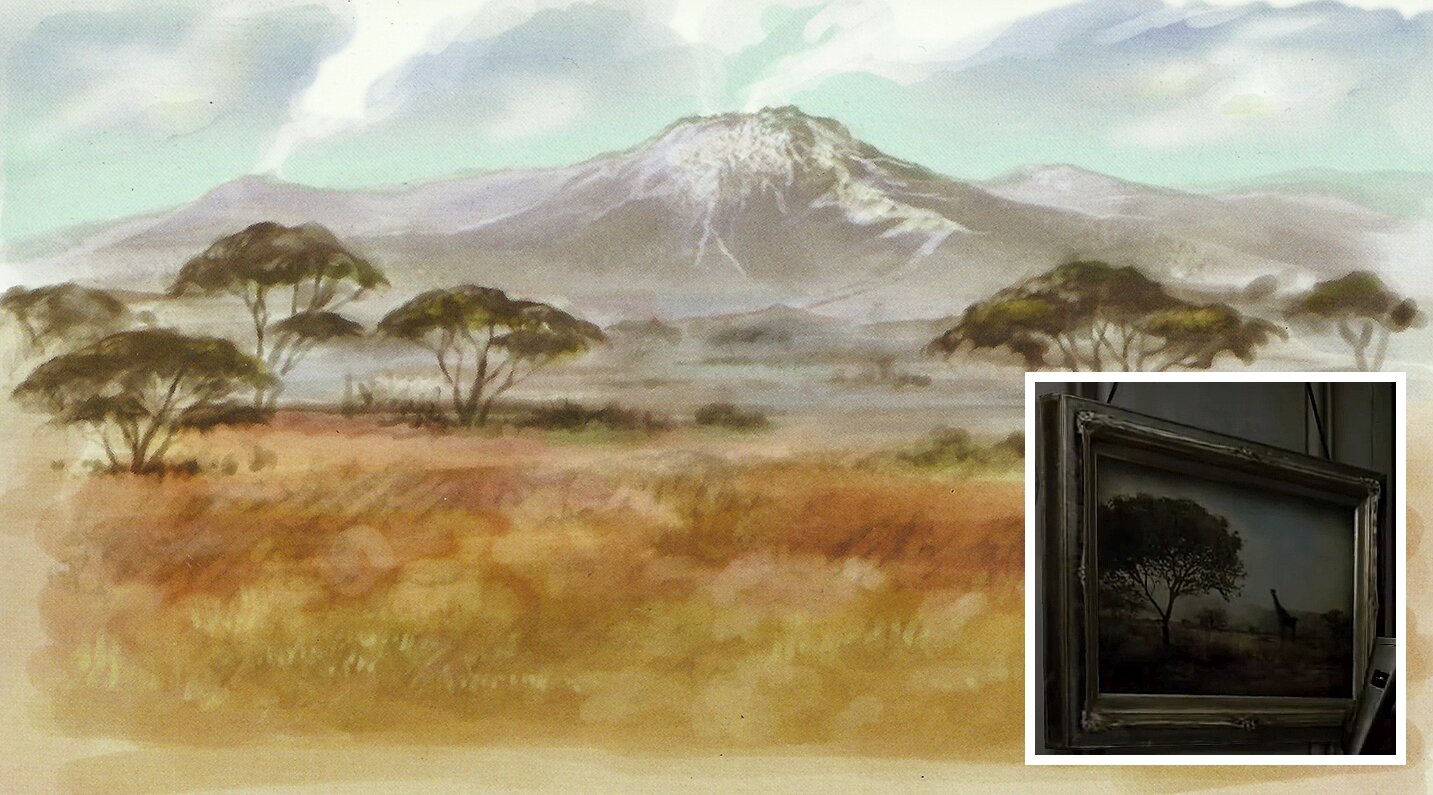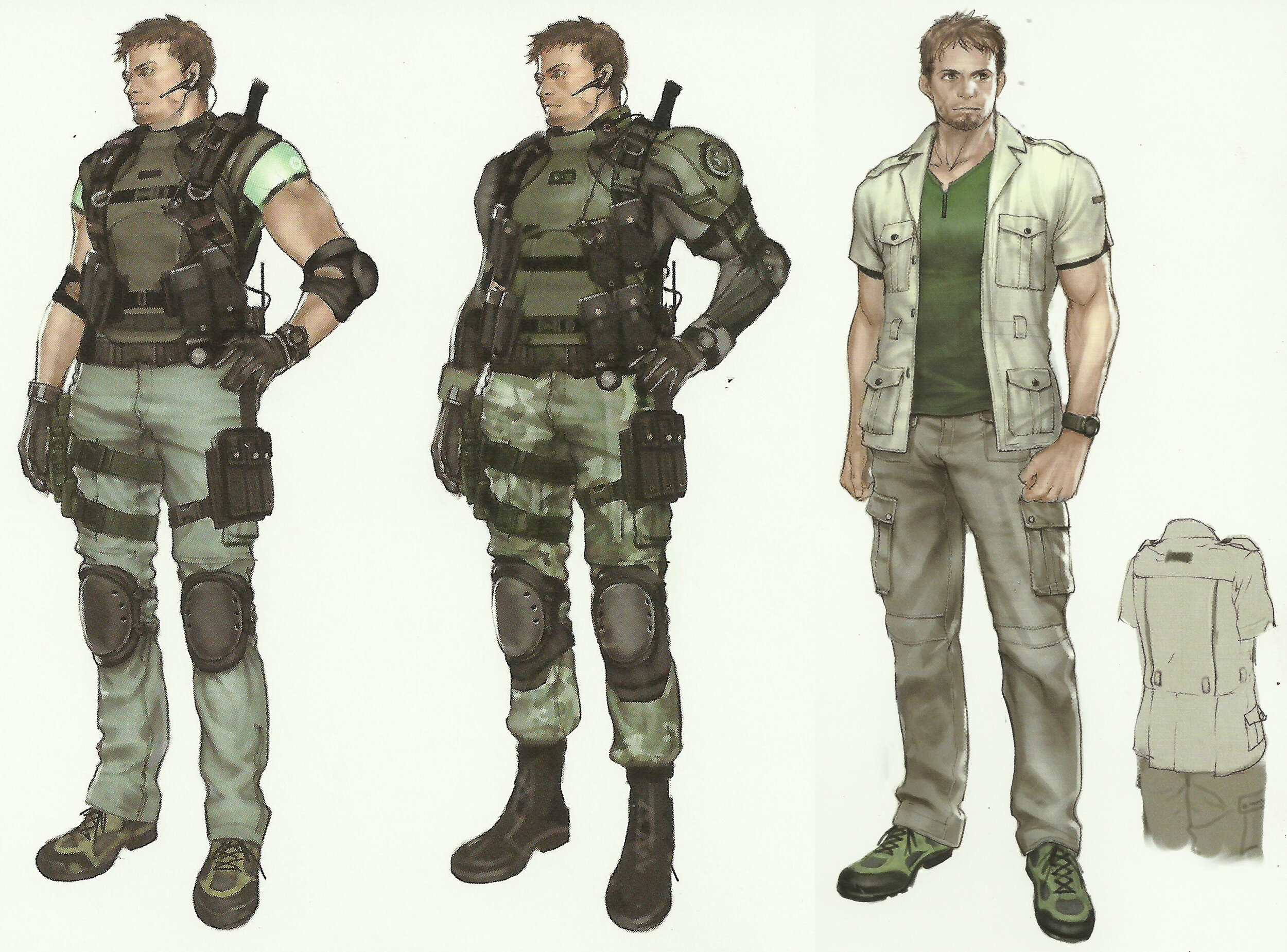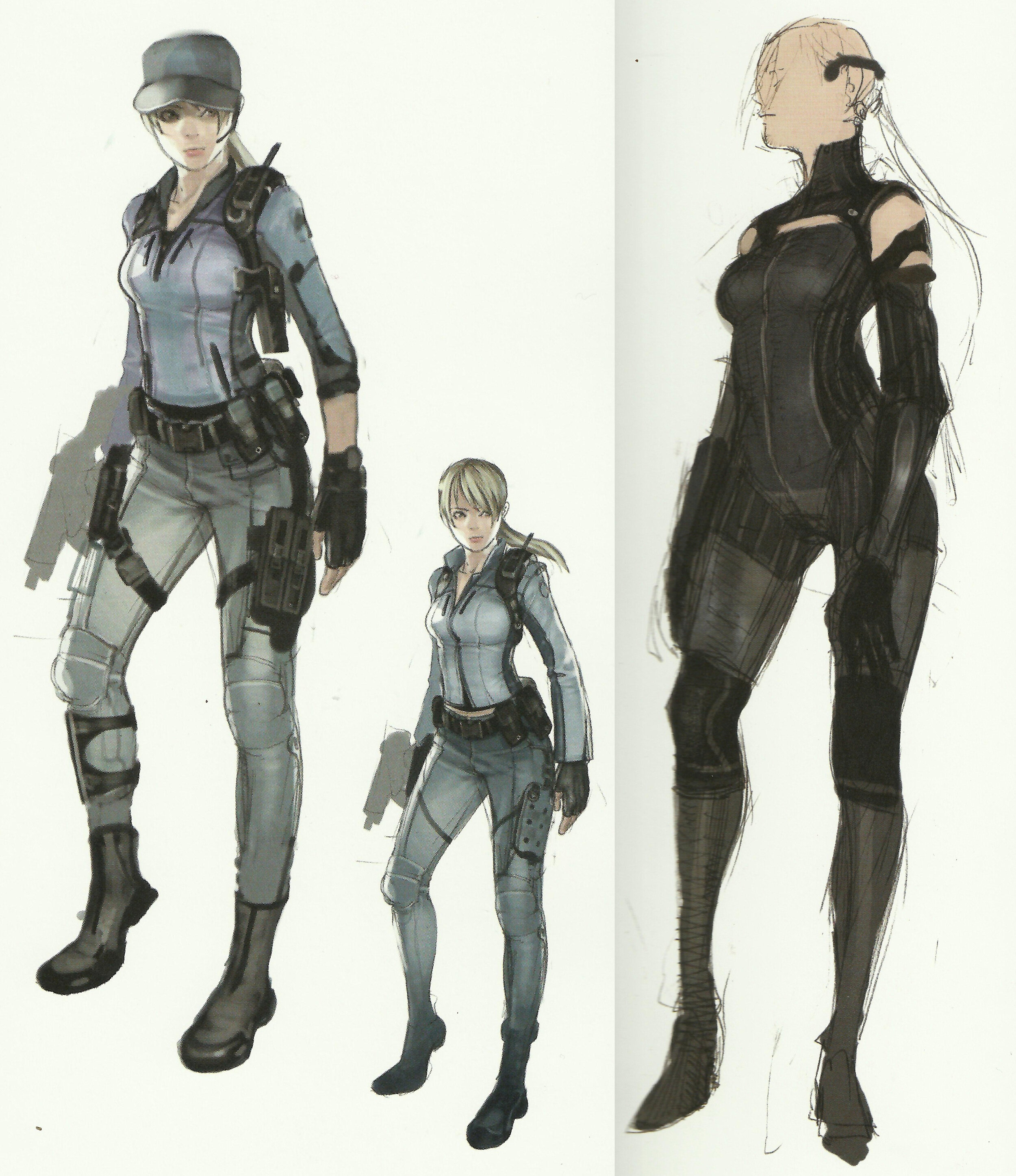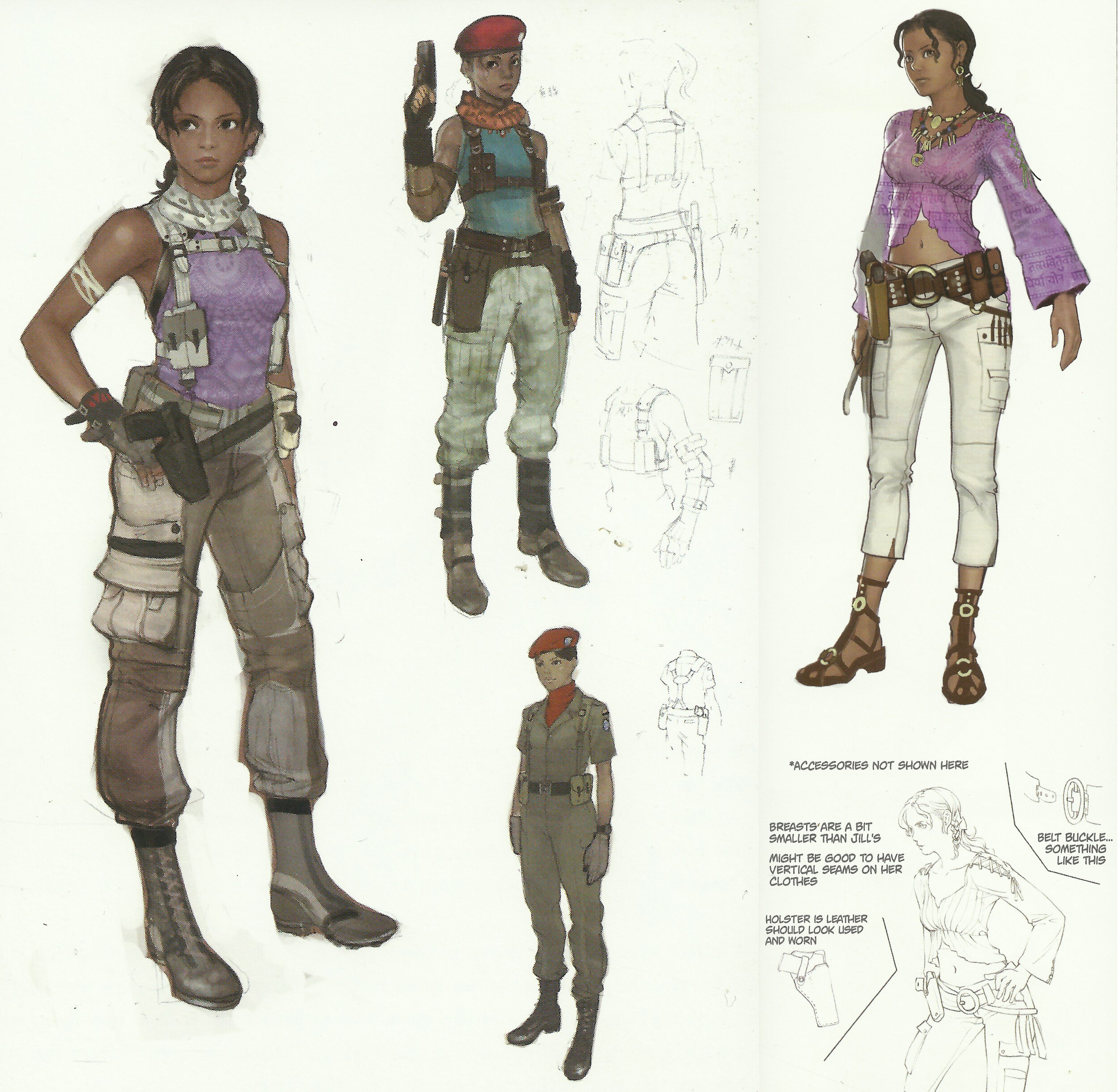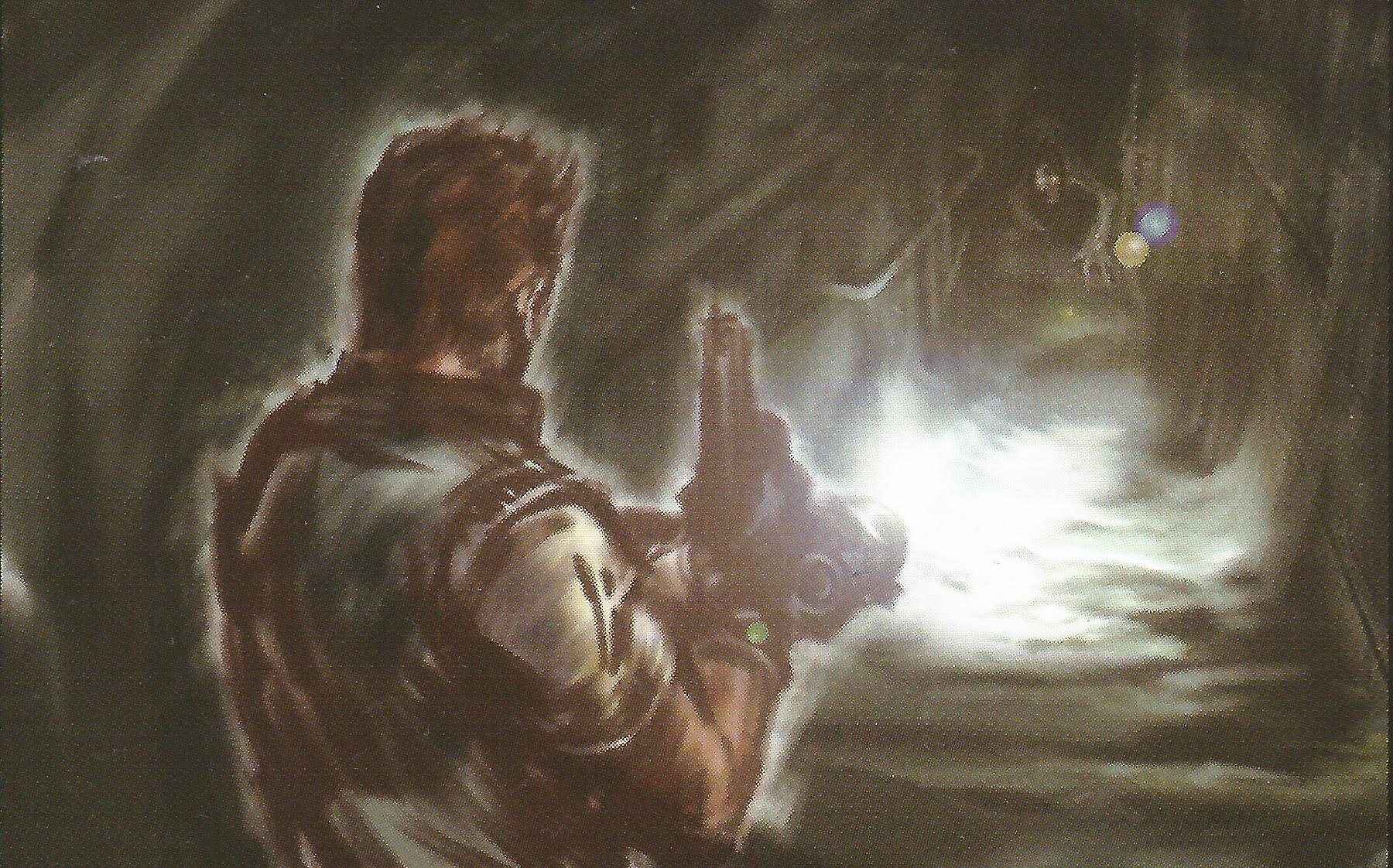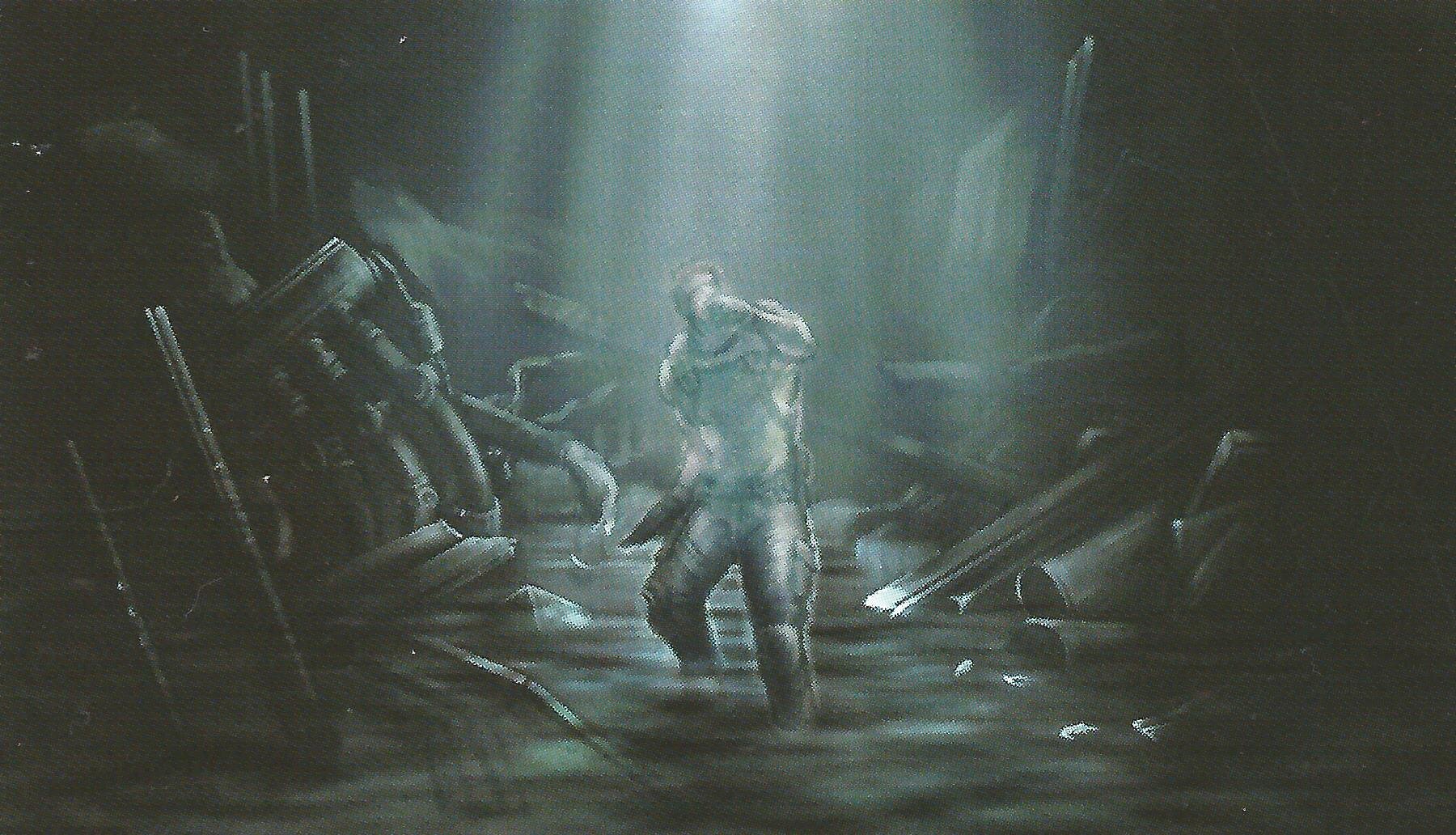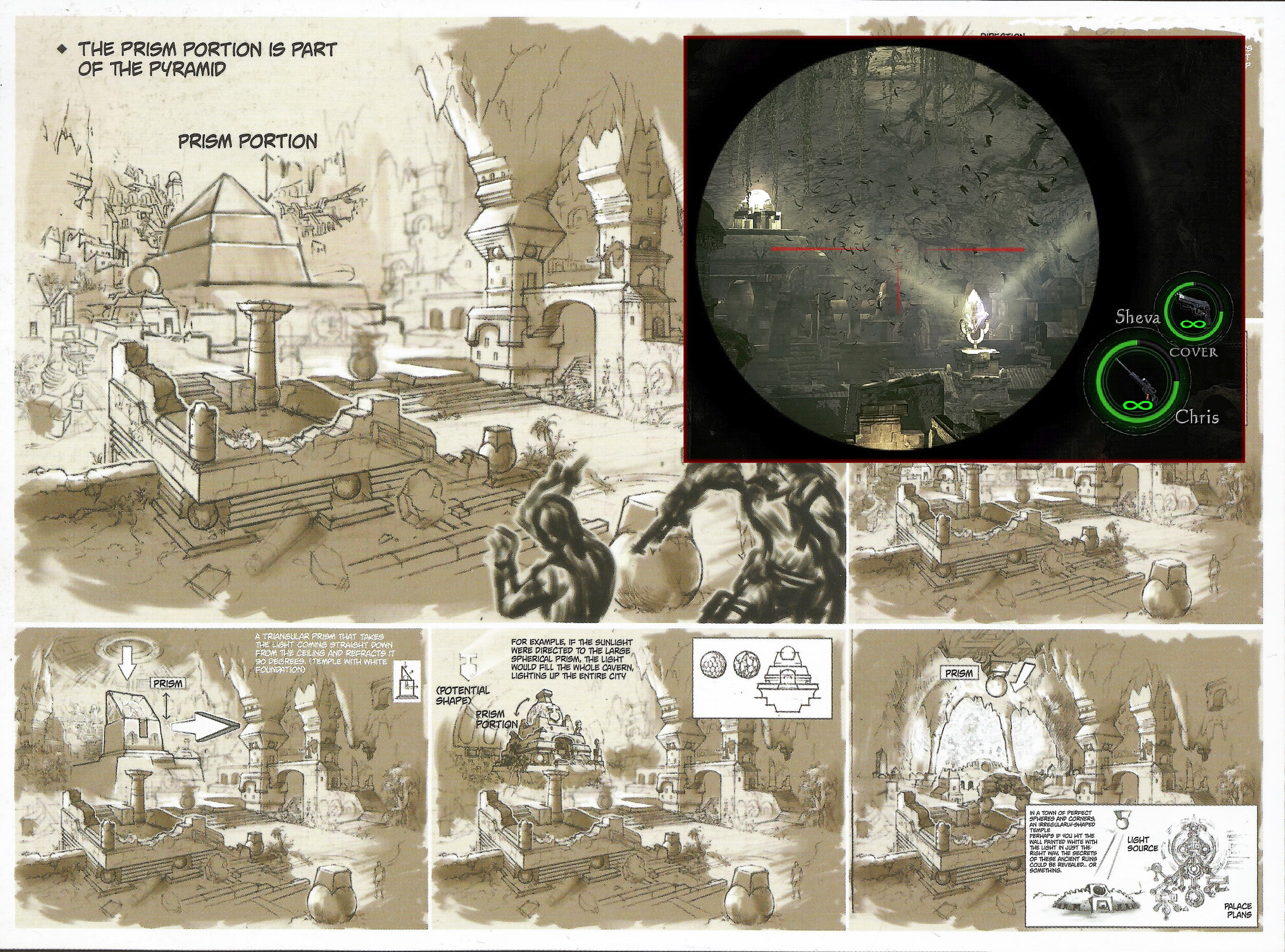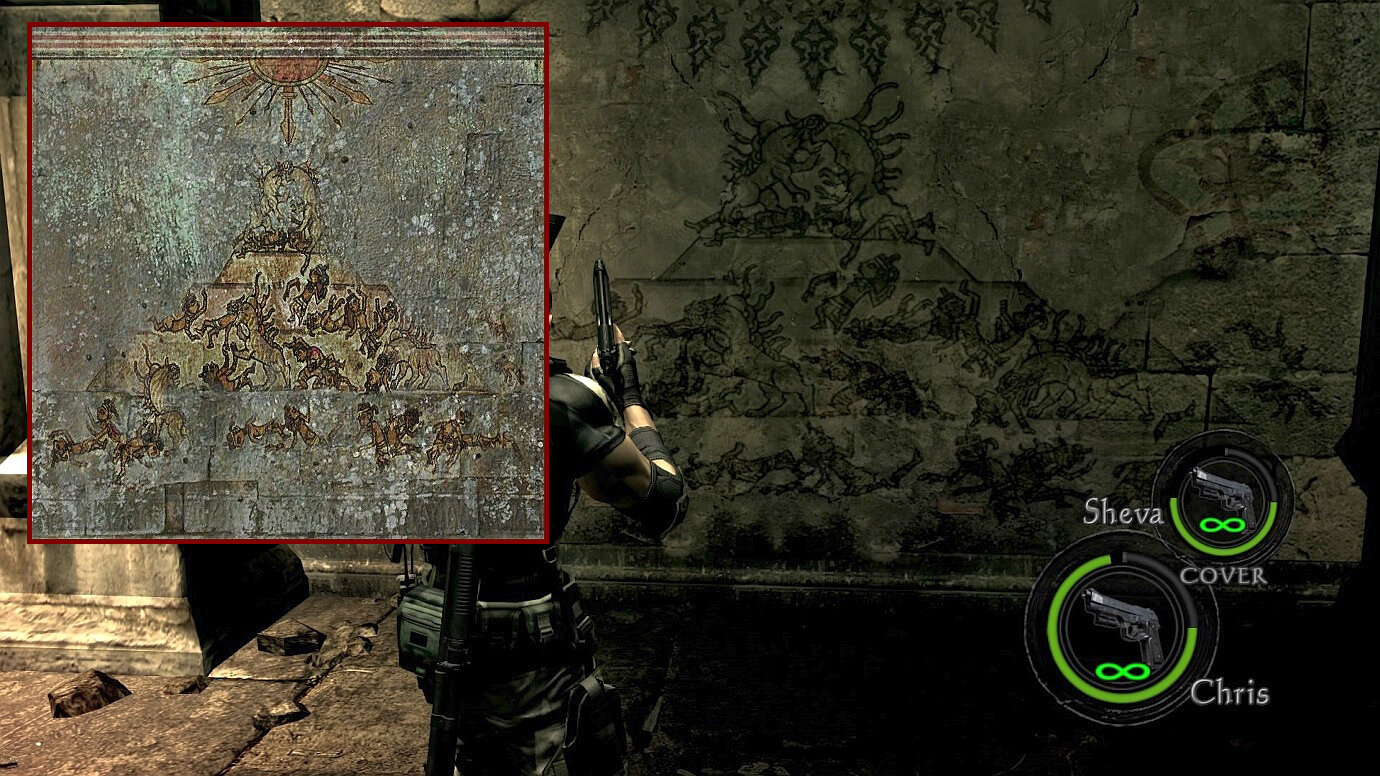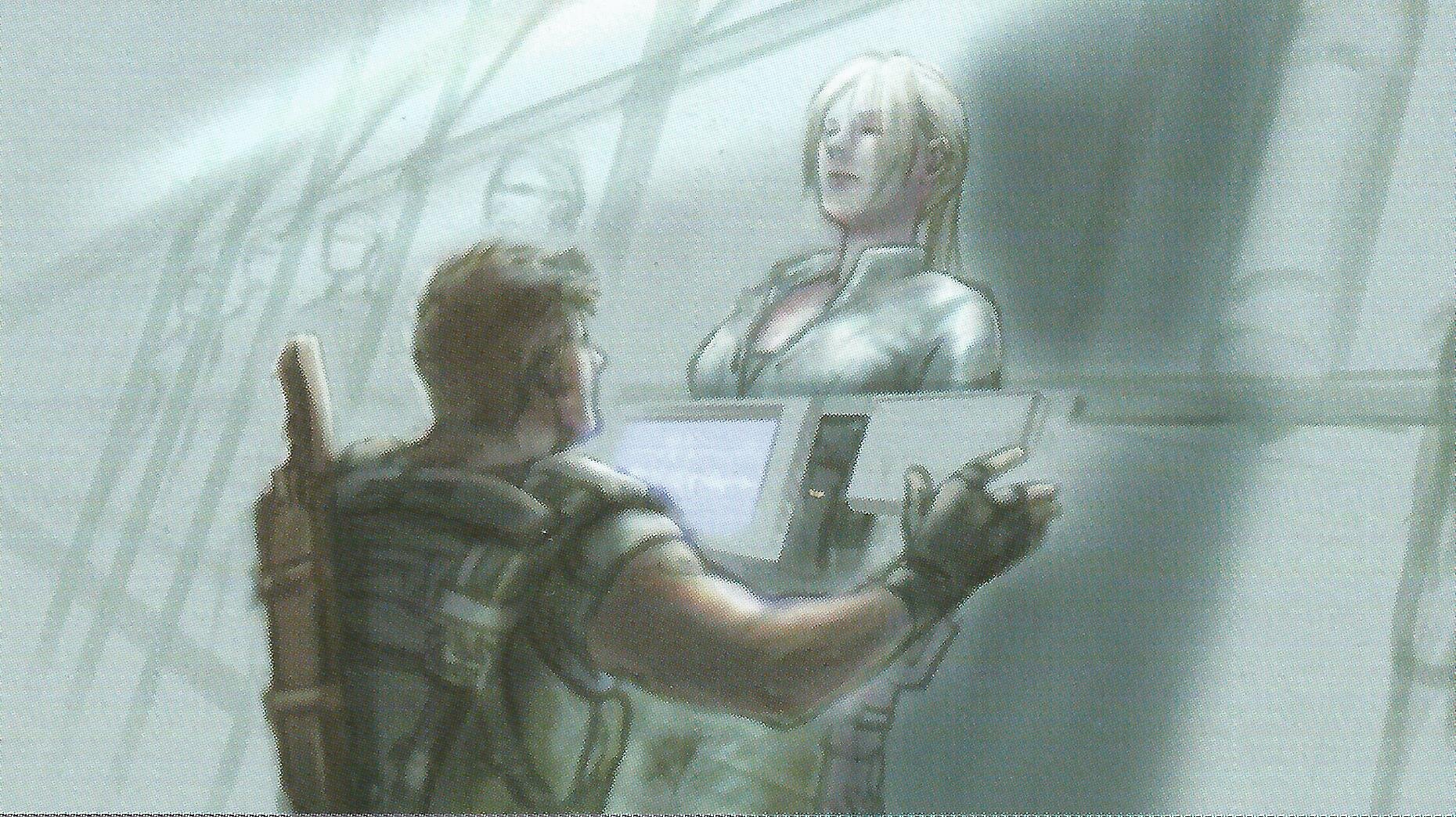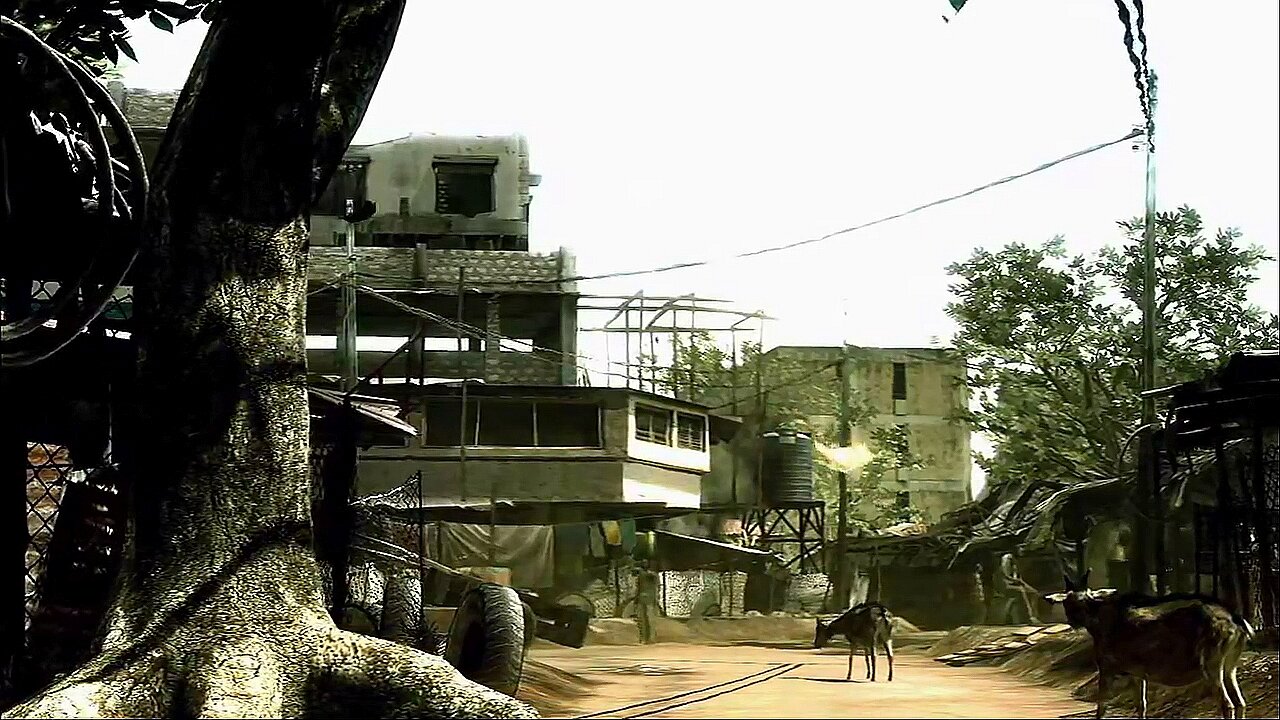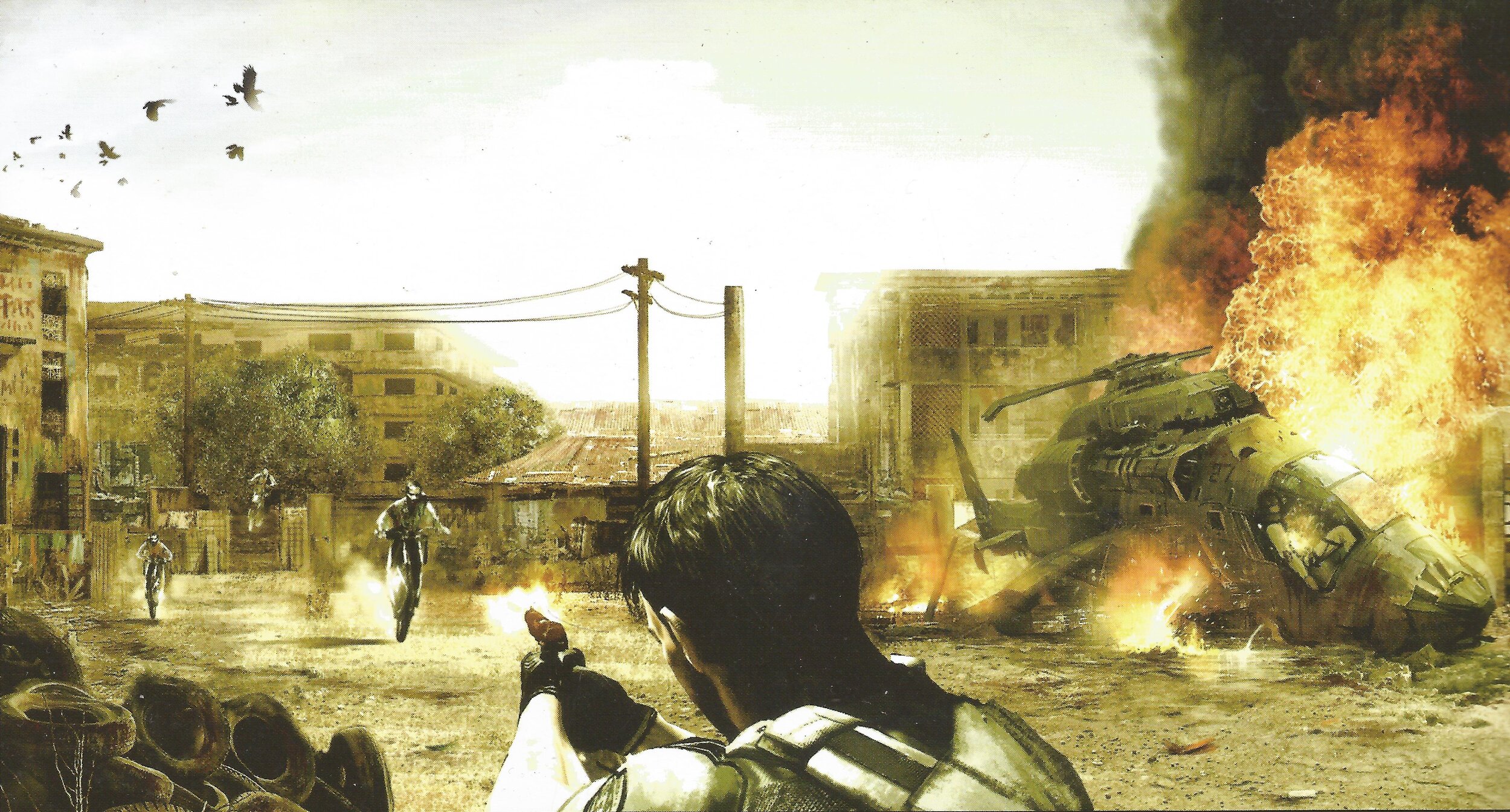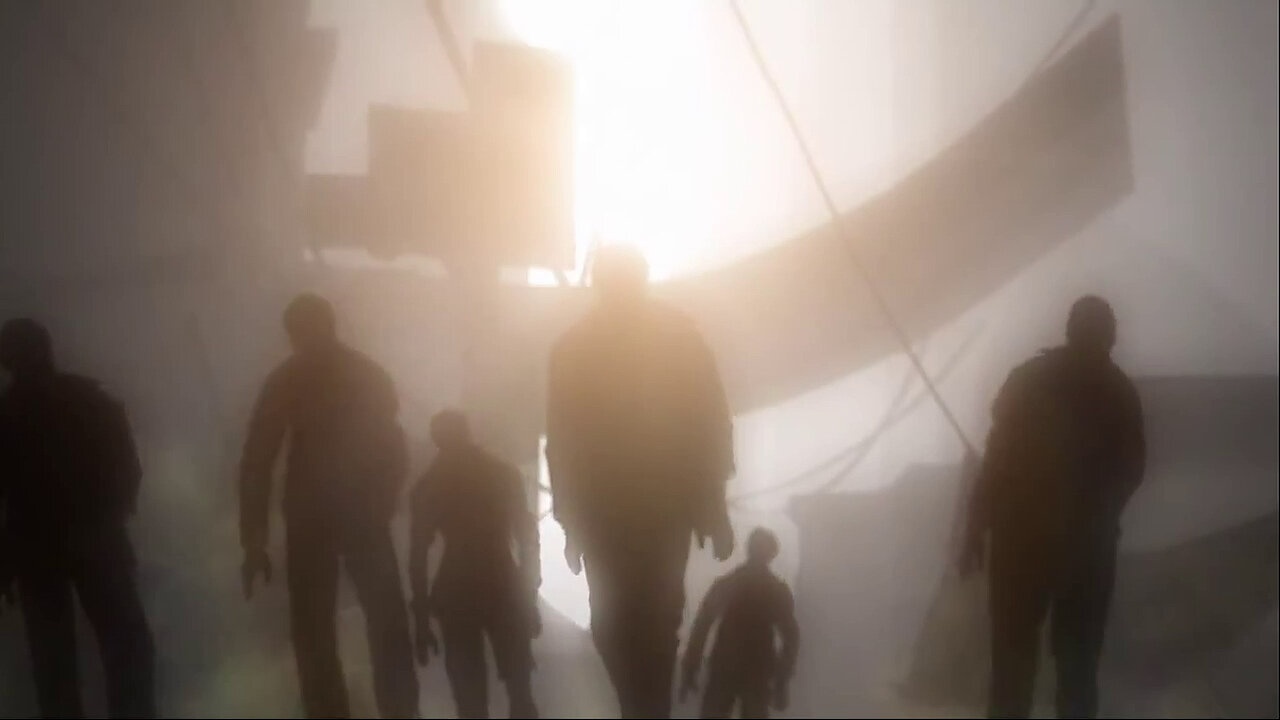
Research article by BSAArklay, covering all Resident Evil 5 beta builds, deleted content, and newly discovered hidden assets!
“Welcome to my article into the varied Resident 5 beta builds & scrapped content. I have great memories of this title and its build up to release was the catalyst in sending me from casual fan, to joining the community & researching the series in greater depth. I have a passion for Resident Evil 5, and its connections to the series, so I wanted to give something back by researching the wealth of known & unknown deleted content, including betas, rare concept art & files I’ve extracted, containing un-seen textures, concepts, and dialogue!” BSSArklay
Quotes from the development team regarding Resident Evil 5 conception and early direction:
"We started development in 2004, and we knew it would be a long road before the game would hit shelves, so we wanted to focus on pushing the technology to its modern limits... The idea we started with was so massive that we had to shrink it down while we were giving it form...": Producer Jun Takeuchi (The Art Of Resident Evil 5)
"The story of Resident Evil 4 was like a side-story, so our aim was to continue the main Resident Evil story as a sequel": Producer Masachika Kawata (Prima Games Interview)
"The launch concepts were to use Wesker, the character of this series; to change the stage of this game to Africa due to the progenitor virus; and to develop this game with Resident Evil 4 as a fundamental base. Co-op play was added to these concepts, which gave us a firm bedrock.": Production Director Yasuhiro Anpo (Prima Games Interview)
"The actual development time itself has been just about three years. If we were to include the time spent in the concept and planning stages, then I guess it would be close to four years. We have pretty much been working on it since Resident Evil 4 itself came out. As for the team size, at the biggest it was about 110 people.": Producer Jun Takeuchi (Joystiq Interview 24/02/2009)
Regarding the implementation of the MT Framework engine, Anpo san states "before the MT Framework, we were all working on games separately, and creating them separately, and it was a very inefficient process, to have lots of different teams separately developing tools to make games. So we wanted to create something that would unify the process."
The début trailer for Biohazard 5 premièred in last quarter of 2005, at Tokyo Game Show, although development started considerably earlier in 2004.
The original Resident Evil 5 logo, showcased in the TGS première trailer, was particularly plain, in contrast to the bright, colourful retail version.
The beta logo differed from the retail version, having a much thicker design, with cracks appearing along the top & bottom, and illuminated by a fire or lava effect. We first get a glimpse at the beta logo in the E3 2007 extended trailer. Both versions are coloured bright orange to symbolise hope for Chris and the rest of the world.
"We had a different logo at first. It had a long jagged crack in the ground... we had already decided that the colour scheme would be sunlight yellow & sunlight orange... The sun represents light, but also fire... these colours are very symbolic and act as a metaphor for the main character... Chris still carries a glimmer of hope, of light. That's what we were trying to convey with our choice of colours." Resident Evil 5 Producer Jun Takeuchi (The Art Of Resident Evil 5)
Development began in 2004; Capcom knew that the game would be a lengthy process before it hit retail, so they made sure to keep up to date with the latest technology.
"When we set out to make Resident Evil 5, the guys knew that if you want to make the most powerful, most pretty game, the Nintendo Wii isn't the best choice.": Producer Jun Takeuchi (Resident Evil 5 Demo MTV.com interview 23/02/2009)
The original idea was considerably ambitious and had to be scaled down over time; however Jun Takeeuchi states that they did try to keep the most impressive features. Right from the start the main theme was decided upon, Chris Redfield versus Albert Wesker, with Spencer E. Oswell earmarked for a cameo appearance. But the game design was constantly changing, right up until release.
"For the story we decided to go with Chris, we looked at what he has done and the puzzles surrounding him, what we wanted to do was solve those and figure out what had been going on... show the origins for various viruses that had appeared in the games and figure out where those had come from... One of the pillars for the story was the Progenitor virus, where it came from? How it was developed... This won’t be limited to the Redfield’s this will go into the origins of the virus.": Producer Jun Takeuchi (Gamespot interview 03/06/2008)
"Once again we have focused on the theme of humans. The contrast between Wesker & Chris has always been an important part of the story... in the Resident Evil series we have all kinds of twisted & tragic events happening, like the murder in the mansion, but it was a human who stood at the root of it all... We knew right from the get-go that this was going to be a story about Chris & Wesker... We also knew that Spencer would make an appearance, even if we didn't explore his character very much.": Producer Jun Takeuchi (The Art Of Resident Evil 5)
The possibilities offered by a new generation PlayStation 3 console, coupled with the MT Framework v1.4 engine, enthused the development team to take on challenges unique to the series; a main game offering an online co-operative campaign, and instead of setting Resident Evil 5 in a dark environment, the unusual decision to utilise the bright, daylight locations of Africa was taken. Assisted by directors Kenichi Ueda & Yasuhiro Anpo, game producer Takeuchi contrasted light with shadows to implement the fear.
"Some felt we should create something with the traditional, dark foreboding atmosphere... As next-gen game, others felt we needed to do something completely new... We really wanted to show the origins of the virus, so for the setting we thought, how about using the place where humankind was born... That's how we came to use a place in Africa as the setting... In doing that we had to set the game somewhere bright. Up to now, light was never a factor in any of the Biohazard games... Being a next-gen game we also saw it as a good chance to create something different... We wanted to maintain the Biohazard-esque feel of the game, and of course when you create light, you automatically create shadow... We're creating a game that is based around light and darkness... When you're in a bright place, it's really difficult to see into the shadow. You're pupil contracts when there is a lot of light, but this makes it hard to see when you suddenly enter a dark place... By focusing on that element, we're able to escalate the player's fear of the darkness. Stepping into the shadows from a place where your eyes have adapted to the light, in those few moments until your eyes adapt, you're playing a game where you can't see... That really fans the fires of panic.": Producer Jun Takeuchi: (Capcom Production Room Interview)
"Having Resident Evil 5 take place in Africa gave us a great opportunity to develop the series not only in the sense of how we use darkness, but also brightness.": Designer Kentaro Yano (Prima Games Interview)
"With the jump to next-gen, a lot of the processing power that you have, as a designer, you want to show off the graphics that you can... something that they've been able to accomplish is take the fear and horror from the past games, and really take it from a place where you can only experience that in darkness and say, 'Well, you can actually do this in the light as well.' I think they've captured the essence of what made the original Resident Evil games so great; they've just done it in a way that takes advantage of the next-gen platforms.": Marketing Director Mike Webster (WorthPlaying Developer Interview 29/12/2008)
Capcom would have had the option to release the game up to two years earlier, but invested considerable time perfecting the visual realism, now offered by a new generation of consoles. Jun Takeuchi instructed his team to take as much time as they needed to attain perfection, and it is arguable that Resident Evil 5 remains, to this day, the most graphically accomplished game in the series, some eight years after its release.
"It certainly was a decision from myself and from the development team that we really wanted to push the next part of the series as far as it could be pushed. That included the graphical aspect of the game. So that was the reason that we went with the 360 and the PS3.": Producer Jun Takeuchi (Joystiq Interview 24/02/2009)
"Lighting effects, physics, sound effects, AI, animation of objects and characters with many joints, big textures, polygon count… not one of these Resident Evil 5 features would be possible on older consoles. If you take a close look, you can see the motion of all joints in each Majini's fingers. We depict flying debris with complex physical calculations, and a Majini's screams rebound from the walls inside buildings.": Programmer Mikio Ueda (Prima Games Interview)
The scenario team headed to Africa to collate reference photos for textures & locations. However Art Production lead designer Yoshizumi Hori had concerns regarding the urban city locations his team visited being too modern and not resembling the classic, generic African visual theme he desired.
Hori-san instructed his team to create more African-esque environments, and to that end they designed scenes that whilst utilising gameplay mechanics, also depicted popularly recognisable African iconography.
"I did these during the early stages. We were talking about how to use the cloth awnings to make it look more like Africa, while including things that would be necessary during gameplay like the blinds.": Background Designer Yasuko Shimoda (The Art of Resident Evil 5)
After trial and error it was decided to shape the stages with a more popular generic design, more recognisable as African locations to the gamer audience. These reference materials were clearly inspiration for paintings found in Resident Evil 5 DLC locations that required a continuation and link to Africa, the setting now chosen to depict the origins of Resident Evil, that was to be a main part of Resident Evil 5's narrative.
During a Games Aktuell interview, Jun Takeuchi was asked if the location for Resident Evil 5 was indeed a real African country, and to identify which language was spoken. "The venue is a fictional country in Africa. The locals speak Suheli." (Credit: Captain Redfield)
When creating the environments for Resident Evil 5, Capcom used real life photos as a source for textures, and for concept inspiration, during the earliest design stage, as can be seen in the source photographs below, extracted by BSAArklay from Resident Evil 5 disc.
A few source photos (extracted from the disc), from a large collection taken by the development team.
Resident Evil 5 concept art for an African themed location, with an inset screenshot, from the Resident Evil 5 DLC 'Lost in Nightmares', of a painting found in Oswell E. Spencer's mansion estate.
During the earliest development stages, Resident Evil 5 had much more of a war/action theme to it. There were numerous allies planned that would assist the player, and allow for gameplay mechanics such as 'protection'.
"I drew these in the summer of 2005. There are way more people here than are in the final game. The characters coloured green are allies... Since the enemies always outnumber Chris and his allies, the player would have had to figure out how to use the allies effectively to win each battle.": Background Designer Yasuko Shimoda (The Art of Resident Evil 5)
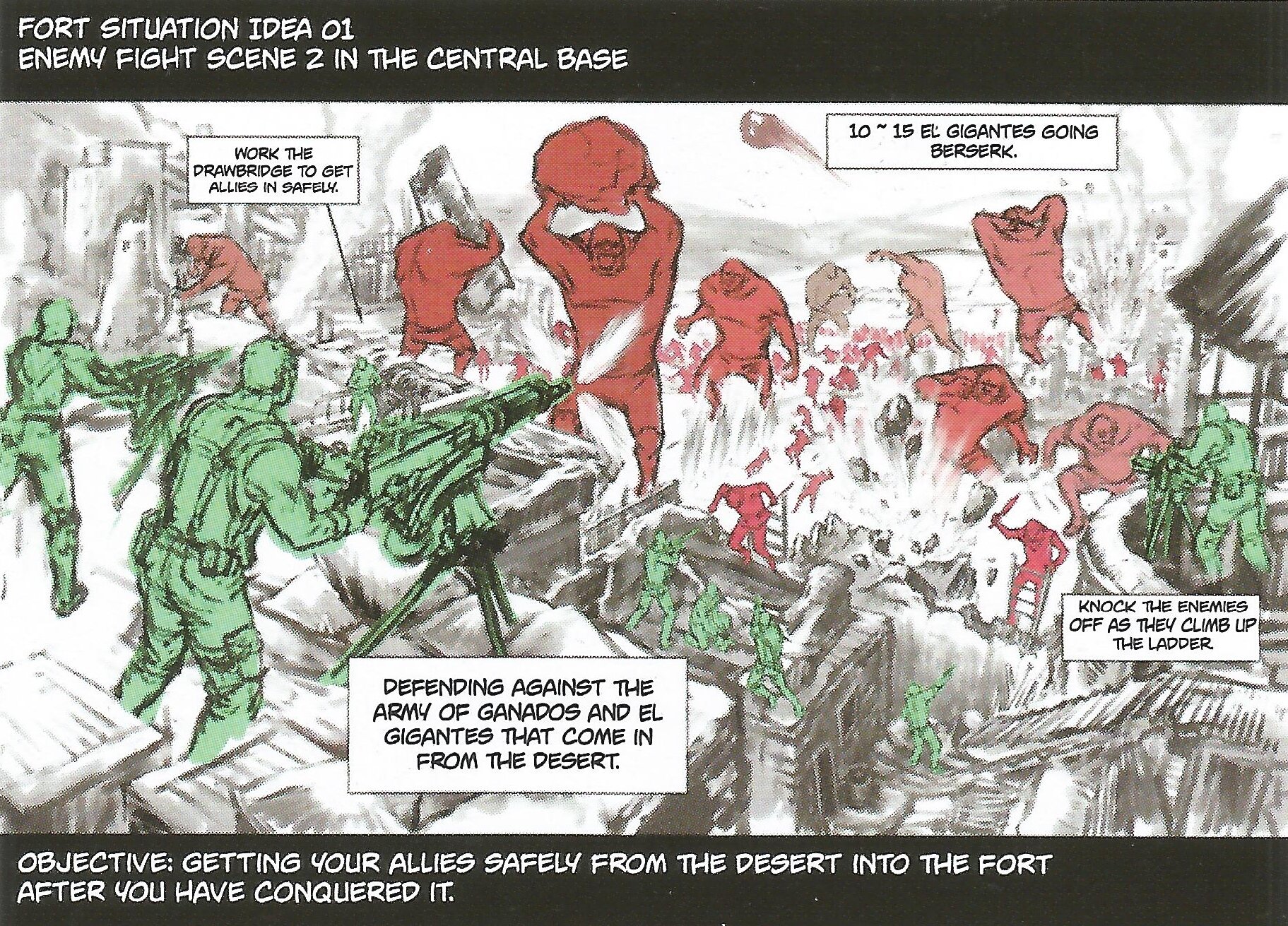
War zone concept area with objective of securing the safety of your allies after clearing the enemy base.
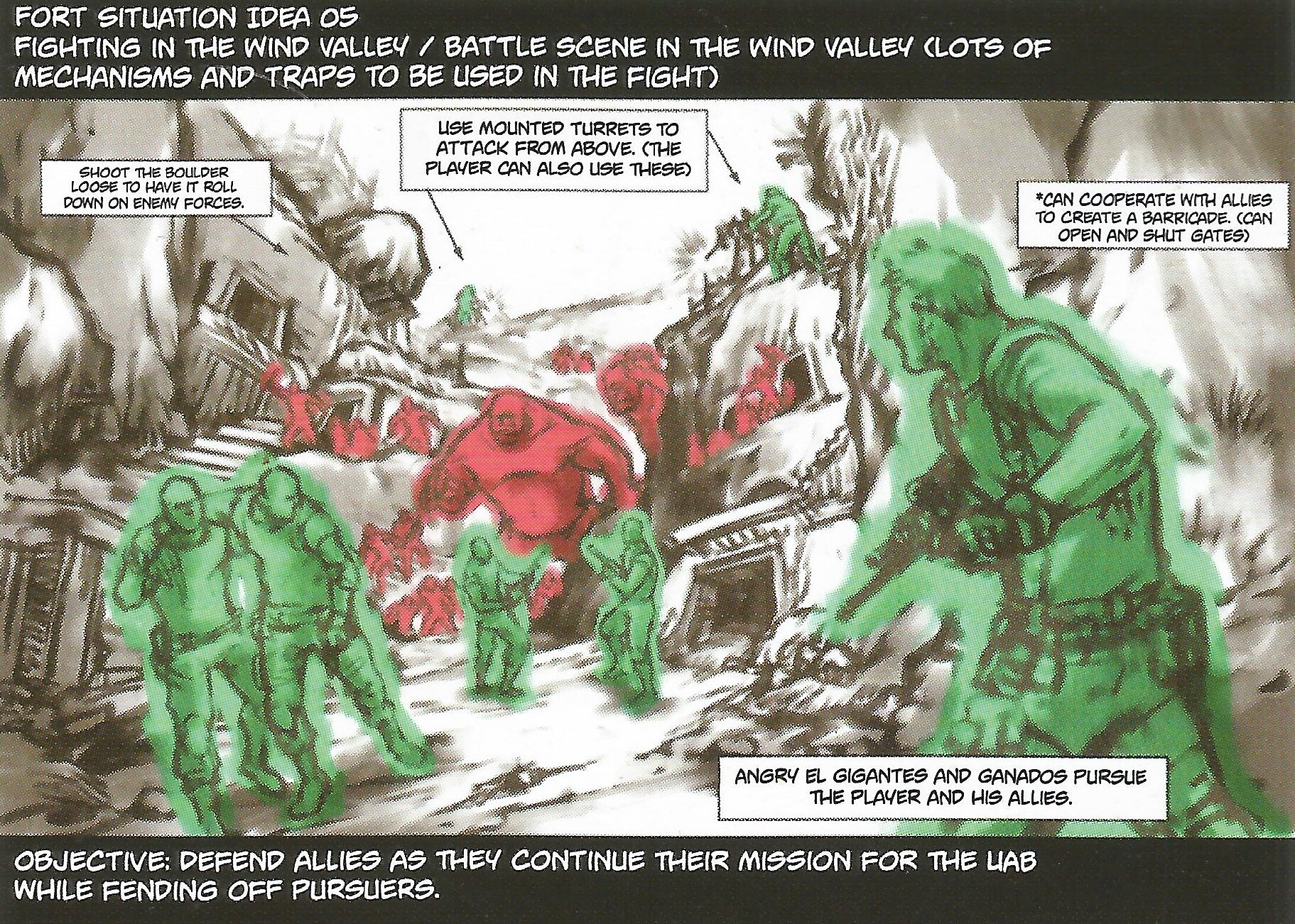
Action concept with traps & mechanisms for use in combat gameplay, with objective of defending your allies.
Production Director Yasuhiri Anpo considered these action and war orientated locations too far removed from the true style of the series. And such was a concern throughout, to respect and adhere to Resident Evil's roots. Hence a continuing challenge in these early days of the game's development, was this African setting dictating bright, sunlit locations, and how to induce the series' signature survival horror despite that.
"I drew this in the spring of 2005, as a piece to maintain the direction of focus for the development team. This is the earliest of early stages in development, when very little of the actual game content had been decided upon. The man in the foreground is Chris, and the woman is his partner, who wasn't decided as Sheva at the time... I kept wondering how I could manage to bring out the Resident Evil flavour in an image with sunlight & Africa, two themes that had never really had a place in the series before.": Background Designer Yasuko Shimoda (The Art of Resident Evil 5)
Production Director Yasuhiri Anpo considered these action and war orientated locations too far removed from the true style of the series. And such was a concern throughout, to respect and adhere to Resident Evil's roots. Hence a continuing challenge in these early days of the game's development, was this African setting dictating bright, sunlit locations, and how to induce the series' signature survival horror despite that.
"I drew this in the spring of 2005, as a piece to maintain the direction of focus for the development team. This is the earliest of early stages in development, when very little of the actual game content had been decided upon. The man in the foreground is Chris, and the woman is his partner, who wasn't decided as Sheva at the time... I kept wondering how I could manage to bring out the Resident Evil flavour in an image with sunlight & Africa, two themes that had never really had a place in the series before.": Background Designer Yasuko Shimoda (The Art of Resident Evil 5)
One method employed to avoid this conflict would be to utilise the darkness of typical survival horror interiors, and with very much in mind, the team began to design the buildings & underground locations that would accompany the outside environment.
"The dark interiors are supposed to bring out the trademark scary feelings that the Resident Evil series is known for.": Cinematic Supervisor Yoshiaki Hirabayashi (The Art of Resident Evil 5)
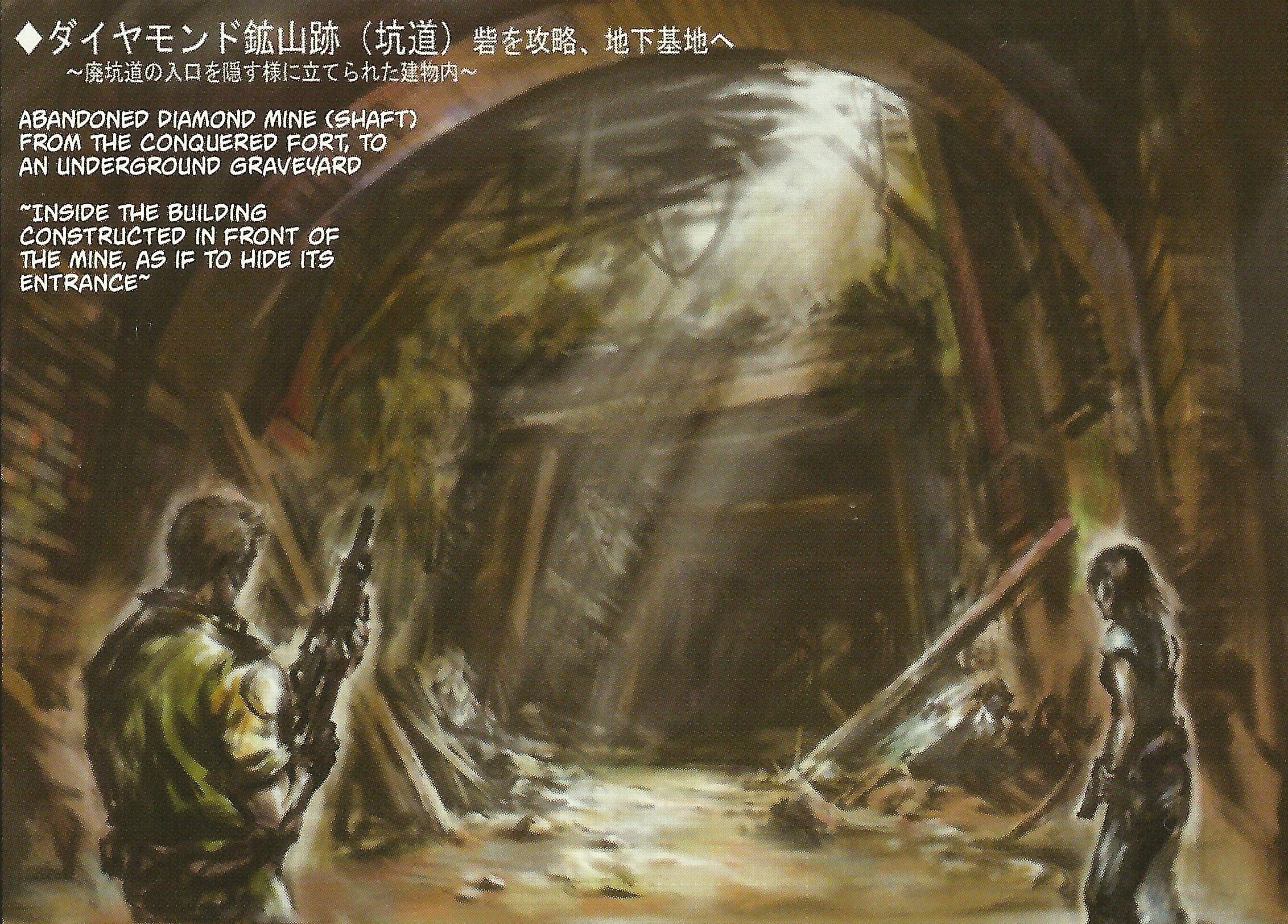
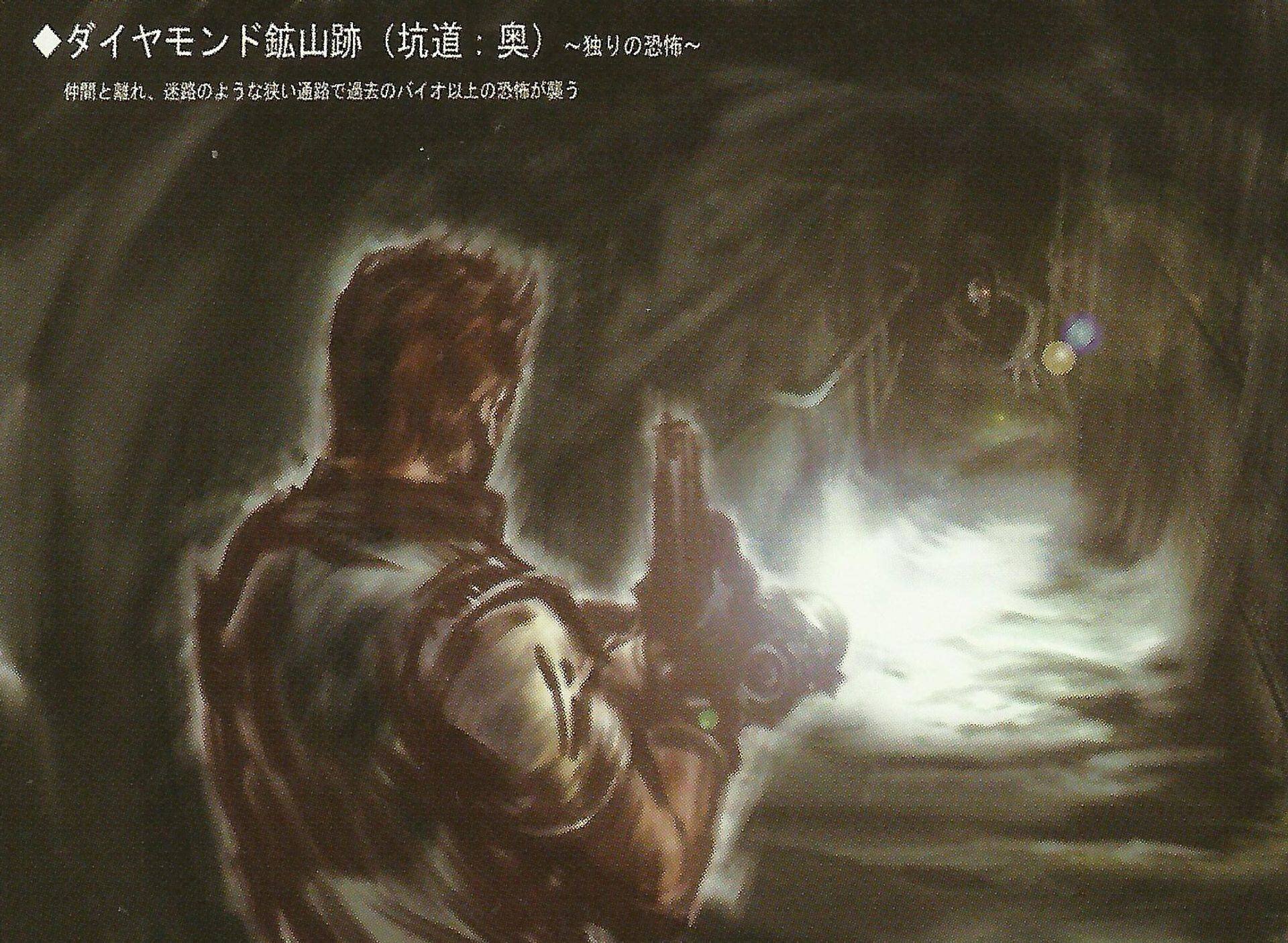
Translation: Abandoned diamond mine shaft from the conquered fort, to an underground graveyard. 'Fear of Solitude' - Separated from the group the player experiences a fear unlike any Biohazard in the past as they wander through the labyrinth tunnels.
"A realistic representation of lighting makes an environment much more authentic, and helps to immerse the player. We achieved this with a variety of visual effect such as tone mapping.": Designer Toru Arikawa (Prima Games Interview)
"Ridley Scott is a director who makes a proper distinction between light and dark. The darkness you see in his movies are truly the blackest of black.": Co-Producer Masachika Kawata (The Art Of Resident Evil 5)
Resident Evil 5 chief producer Jun Takeuchi stated that the development team were very much inspired by Shinji Mikami’s work on the game's predecessor, however they clearly wanted to avoid suggestions of plagiarism, and knew they would also fail to match the survival horror icon's creativity, if they were to attempt to copy any gameplay mechanics from Resident Evil 4. Takeuchi-san was also mindful that it was imperative to progress the series forward, for its own survival, with sales figures for the series on a consistent downturn, since the records set by Resident Evil 2; and with that his attention turned to those gameplay mechanics that could provide the necessary innovation to turn the financially flailing series around.
"For Resident Evil 5, a lot of the elements in it are a refinement of things that we had in Resident Evil 4; making them better, and choosing which elements to keep, which elements to discard.When we first sat down to design Resident Evil 5, we decided that changing fundamentally the way that Resident Evil 4 worked was something that we did not want to do. So that was one of the most important parts of that design process.": Resident Evil 5 Producer Jun Takeuchi (Gamasutra Interview 15/08/2008)
Only the first Resident Evil 5 beta scenarios featured a lone Chris Redfield, chosen as sole protagonist of a single player campaign. But with Capcom's MT Framework engine and tantalising power of a new generation PlayStation 3, the ambitious decision was taken during early stages of development to upgrade to co-operative gameplay.
"We wanted to create a new experience for the player... to advance the series on from Resident Evil 4 and to allow the users to do something in the game that they have never been able to do before. Our answer to that was co-op; to allow the players to play with a partner and to experience the game in a different way.": Resident Evil 5 Producer Jun Takeuchi (Joystiq Interview 24/02/2009)
"I think the main feature is co-op. A lot of what Takeuchi-san tried to do when he took a look at Resident Evil 4 and tried to lay out what he was going to do for Resident Evil 5 was really take a look at how franchises fail as they progress, and one of the things that I think he identified was that they really don't innovate very well. So that was really a big focus of his.": Marketing Director Mike Webster (WorthPlaying Developer Interview 29/12/2008)
"We were afraid of losing the fear and atmosphere you enjoy as a solitary player by introducing co-op as a primary feature. But then we thought: co-op is just like entering a haunted house with two people, and this was a big leap forward. We thought a great deal about the survival element, in which you must co-operate to survive. I think this combination of RE and co-op has more advantages than disadvantages.": Production Director Yasuhiro Anpo (Prima Games Interview)
During these level design stages, the shadow cast by Resident Evil 4, spread to influence many in the development team, to such degree that the idea to include co-operative gameplay, was first met with reservation.
"It was something that we included part way through the development of the game. I always had the idea that co-op was something that was going to be necessary in Resident Evil 5. But just when we started planning and making the game right at the start, the pressure to outdo Resident Evil 4 was so strong that it was difficult to get everybody in the team behind the idea of doing a co-op focused game.": Producer Jun Takeuchi (Joystiq Interview 24/02/2009)
"In terms of the co-op element, it was time to introduce that element to the series, to liven up that aspect of the series and also to give ourselves a new challenge. To give us something new to bring to the series, and to give ourselves something new and challenging to do.": Producer Jun Takeuchi (Gamasutra Interview 15/08/2008)
With Chris Redfield decided upon as main protagonist, and concept art illustrating a female partner to utilise the required co-op gameplay, Chief Producer Jun Takeuchi now turned his attention to this character, and whether to draw upon the series past roster of recognisable protagonists, or to create a new one.
"There was a long list of characters that came up as candidates. Every one of them had strong enthusiasts amongst the team. Satisfying all of them would require us to line up all the characters and create a variety of stories corresponding to each of them. It was just impossible to create such a volume of work, and that would also make it difficult to establish the story line we had planned. Additionally, staging within a new location required us to bring in a local guide, one who is familiar with the region. All of these factors convinced us to use a brand-new character.": Producer Jun Takeuchi (IGN interview 14/07/2008)
"Originally Chris was going to be the only main character. With the addition of Sheva, and co-op actions, we had to redo the map at least twice... Though she started off as a regular sub-character, changes in the scenario led to changes in her character. When co-op was brought in, it made Sheva a BSAA agent, and we made her more of a combat-orientated character": Production Director Yasuhiro Anpo (The Art of Resident Evil 5)
Chris’s appearance and role as lead protagonist in Resident Evil 5 was decided from the get go. At concept stage character modeller Yosuke was given instructed to make Chris’s muscle structure as visibly enhanced as possible. The reasoning behind this was to give the clear impression that Chris had been training for his confrontation with Albert Wesker, and if necessary Chris wanted to be physically prepared and capable to take down Wesker with his bare hands! So instructions went out to 'make his neck thicker than his head, and his arms should be super thick too, like inhuman thick.' Moreover, Chris’s original design had considerably bigger arms than the final CGI version. Additionally he sported scruffy facial hair, and an unkempt hairstyle, to make his appearance look wilder.
"We created his equipment with reference to military hardware in the real world to avoid being outdated or unrealistic. We also drew upon photos of soldiers and PMC (Private Military Company or mercenaries) in the field to recreate the ‘wardrobe’ typical of troops involved in military action. We got help from a Japanese military store during the game's development. The owner of this shop imports and sells equipment. We borrowed real body armour, holsters, night vision goggles, gas masks and other gear as research material.": Modeler Yosuke Yamagata (Prima Games Interview)
"I also worked on the first Resident Evil, so I have known these characters for a long time. I tried my best to preserve their image and imagined how they would have changed over the passage of time. Chris trained and got stronger.": Production Director Yasuhiro Anpo (Prima Games Interview)
As you can see in the variations between these early concept outfits, Yamagata-san experimented with various ideas, particularly differing levels of militaristic symbolism (Metal Gear Solid esque), and while this could be considered more realistic, he also wanted to take into consideration the extreme heat in Africa. Consequently Yamagata-san decided to progress with an outfit that Chris would find easiest to manoeuvre in, whilst keeping him cool.
"I wanted to give him clothes that would allow him the freedom of movement that any superhero should have, while mixing components from military styles and sportswear. I made sure to give him a 'next-generation' feel when I was drawing the materials and other details of his clothes.": Modeler Yosuke Yamagata (The Art of Resident Evil 5)
The earliest placeholder design for Chris Redfield's partner, was of a mysterious figure wearing a hooded cloak, covering much of her appearance, and much like her unlockable fairy tale alternate costume. In the concept artwork below, Lickers begin to surround the player, climbing out from hidden areas to overwhelm our protagonists, while B.S.A.A. helicopter support arrive just in time to effect an escape by air. This beta scenario failed to make it to the retail build.
"Though she started off as a regular sub-character, changes in the scenario led to changes in her character. When co-op was brought in, it made Sheva a BSAA agent, and we made her more of a combat-oriented character": Production Director Yasuhiro Anpo (The Art of Resident Evil 5)
Sheva Alomar was originally set to be a member of a private militia however she was given a bigger role to become Chris’s partner in co-op. When Sheva was still in the private militia phase her attire was much simpler. It was only later when Sheva was partnered with Chris that her attire was changed to the more advanced military gear. Takeuchi-san states that Sheva was created purely for the purpose of 'being someone familiar with the environment, somewhat of a guide for Chris'. This may be true, however one has to wonder whether Sheva was afforded a much larger role in the game (perhaps replacing Jill) due to the racism contention that arose after Capcom released the E3 2007 extended trailer (more on this later).
Sheva’s favourite style of combat was martial arts, so this affected her choice of weapons, necessitating her to carry the lightest weapons possible, thus allowing her ease of manoeuvrability when in hand to hand combat.
Yamagata-san wanted to make sure Sheva stood out from the African daytime scenarios. To achieve this he used a lavender colour scheme. He was also mindful not to design the character too feminine so as to look physically awkward for the trials ahead, whilst keeping sufficient femininity to imbue players with strong desire to protect her. This conflict was quickly averted, when Ampo-san confirmed 'I like slender girls'. Furthermore, many in the design team were not happy with Sheva’s face on several occasions, with Yamagata-san directed to ‘make her cuter’.
"We discussed many ideas for her background. Sometimes she was a civilian or a guerilla, sometimes she was a commander of a military corps. In fact, we made in-game models of Sheva for some of these ideas. But there were certain desired constants in all iterations: beauty as a heroine, ferocity and determination as a fighter. Finally, we chose the current design which is contemporary, as with Chris, mixed with a wild look appropriate for the assignment in Africa... We then had to adjust the modelling several times after she appeared in-game until we got positive feedback on her appeal. Our visuals staff suggested an adjustment to her in-game lighting so that she looks more charming.": Modeler Yosuke Yamagata (Prima Games Interview)
"The designing of a female character is a killer assignment. We had to change and modify Sheva considerably to combine two qualities, feminine attraction and the strength of a fighting woman.": Production Director Yasuhiro Anpo (Prima Games Interview)
"We made a new design that retained their signature colour, green for Chris, blue for Jill, to carry over the same look from the past. The facial structures are mainly based on the visuals of the GameCube version, and we added various details to these in order to develop a realistic texture.": Modeler Yosuke Yamagata (Prima Games interview)
"Jill's theme colour is still blue... the fact that her hair changed colour when she became an enemy really accentuates the change in her character. I enhanced her raccoon-like features, with heavy lips, relatively larger eyes and nose, and brushed her up to bring out the texture of her skin and veins... I didn't receive instructions to give her different outfits for before she gets caught by Wesker and when she shows up as an enemy, but it was something I chose to do... The close-fitting clothes she is wearing are supposed to give the player the idea that she had been experimented on while captured.": Modeler Yosuke Yamagata (The Art of Resident Evil 5)
Below image shows concepts for Jill Valentine during the Majini bike assault. During this beta stage the Sheva Alomar character had yet to be established, with a focus instead on Jill Valentine and her platoon. Although still in early design, by this stage Capcom had decided to drop zombies as standard enemy, (initially preferred to develop connection with the original Resident Evil game), moving forward with Ganado’s.
From the time of these earliest concept designs, it was always a part of the narrative that Jill would die. The development team considered gameplay stages were Jill would meet her demise, depending on player actions.
As with Chris Redfield, the character of Albert Wesker had been decided upon from the outset, before any concept stages had been planned, before any other character designs. A small note in his early design concept states ‘confirm model of gun’. It is possible that Yamagata-san was told of the Samurai Edge and this was to be an integral part of the story. The design team wanted to give Wesker a spy theme with the clothes he wore looking futuristic.
The earliest concept sketches of Wesker interacting with his Uroboros mutation was considerably different to the final build. The inclusion of foreign objects such as metals had yet to be designed, the developers instead opting to focus on Wesker's ability to control Uroborus by sheer will alone. Prior to the addition of metal shards during his battle with Chris Redfield, Wesker's combat style would have been very different, using only the power of mind he could extend and contract Uroboros. Furthermore, it was at this earliest development stage, when the battle with Chris did not involve a co-op partner, just one on one battle between these two bitter rivals, that allowed for such a fighting design. Wesker having no requirement for additional 'weaponary', however, with the inclusion of Sheva Alomar co-op for this final boss battle, he needed beefing up!
Initially Excella Gionne was going to be a secretary, with the CEO role going to a male figure. Far removed from her strong presence in the retail version, the character's earliest conception was that of a feminine secretary, far more submissive, and in a sexual relationship with Albert Wesker. Yamagata goes on to state that when they changed her role to the CEO the design team decided to make her attire similar to a celebrity style.
Excella went through several different changes in her design and there was much conflict between the staff concerning 'makes a great woman'. In the BSAA Desktop at the very end, an animation can be seen where Ryan’s blood splatters across the screen and a silhouette of M Suzuki appears behind him, on the monitor. That silhouette seen is the exact concept model as Excella’s secretary attire shown in early concept art
Ricardo Irving had a less significant role in the early concept stage. One of his earliest character designs was that of a small-time crook, a loser with flaws and insecurities due to such persoanl failings.
Here we see Irving originally cast as a test subject, evidenced by the bar-code imprinted on the back of his neck.
His mutation was not always to turn into the aquatic bio-weapon seen in the retail version. Before Uroboros concepts had been created and decided upon, Irving's original mutation was of a design similar to that of a Tyrant!
Once the Uroboros mutation became integral to the enemy designs, and the game's development was at the stage where it had been determined Irving would mutate into his Uroboros form for a ship battle, concept art for this revised Irving monster had to be designed. And the first revisions for a seafaring creature were quite different from the final retail build; these earlier concepts are clearly influenced by Octopuses. These designs were passed on, considered too slow a creature for keeping up with a speeding ship.
"The design team took precedence on creature design in Resident Evil 5. They defined enemy characteristics, like their role, action pattern and so on for the art team. The two teams had various discussions and the artists prepared many rough designs from the results. This enabled us to chose the visual look of the creature. In rare cases we began with the creature's appearance and expanded the game idea from that image, like in the case of Uroboros. Sometimes we created a new character from art to remedy any lack of visual excitement following the gameplay development.": Modeler Yoshinori Matsushita (Prima Games Interview)
Possible scrapped Irving story in the earliest beta scenarios? Well, within the BSAA desktop (a supplemental website released in conjunction with Resident Evil 5 as a part of the marketing campaign alongside 'Adam's Blog' and the 'Famitsu Biohazard 5 Blog'), a file does state:
'Moreover, there are questionable documents claiming he was in Raccoon City during the tragedy in 1998, though it is difficult to confirm this because a large majority of records has been lost.'
In Resident Evil Remake the 'Laboratory Security System Information' file tells us that a 'Keith Irving' was the Visual Data Room monitor, in the Arklay Mansion laboratory! Perhaps a relation to Ricardo Irving, and the connection linking him to this canon reference of Ricardo being present in Raccoon City during the 19998 tragedy? It's possible Irving had a back-story that never made it into the game, stretching back to a beta build. His father (Keith) perishing in Raccoon City is a likely explanation for Ricardo’s future criminal descent, forcing him down a dark path selling bio-weapons on the black market; moreover as a way to enact revenge on a world that saw the loss of his family to a biohazard outbreak! Very similar to Curtis Miller’s character arc in Resident Evil Degeneration, perhaps explaining why this part of Irving's biography was scrapped - due to the similarity, and that both instalments were in development around the same period.
The only enemy characters Capcom had decided on from the start of production were zombies, even the Majini were yet to be conceived into the game. Zombies played a significant role in the early stages of the game, such as the public assembly stage. These zombies differed from previous versions by having the ability to run. Even though zombies, they still had the ability to aggressively rush the player.
Still in early scenario design stage, and the development team decided to switch directions, promoting newly conceived Majini enemies over zombies. This was due to concerns within Capcom that another zombie based game was too tired an enemy concept to appeal to the wider audience, so desperately needed for the series, at this precarious time in its history; Resident Evil 5 had to progress the franchise forward and produce significant sales figures, arguably for it to survive. Furthermore, zombies lacked the intellect to communicate, hold weapons, and of particular significance, lacked the ability to organise group assaults, a gameplay mechanic the development team wanted to implement, mindful of series progression.
These unused creature concepts were designed to confuse their pray with illusions, triggered by this enemy emitting a gaseous substance. When the player came into contact with this gas, a gameplay mechanic would see the screen change to a distorted thermal view.
After dropping these illusion creatures, the design team then set about creating a collection of parasite Plaga creatures that required human hosts. Resident Evil 5 Modeller Yoshinori Matsushita who created these types of enemies, also added variants of the B.O.W. with an ability to use the illusion gas. One such enemy that would emit this gas was approved at one stage, adorned with psychedelic colour, in keeping with the hallucination theme.
When the decision was taken not to use Plaga types requiring human host, Matasushita-san then attempted to evolve his creature to fit the game’s theme; sketching concepts that were stand-alone creatures. However his concepts were all rejected, with this variant of the hallucination B.O.W. finding its way to the cutting room floor, with all the others.
"These were done back when we were still planning on using zombies. As the setting was Africa we put jagged cracks in their flesh to give them a dried flavour even though their skin was quite damp & squishy.": Lead Character Modeler Makoto Fukui (The Art of Resident Evil 5)
The Majini’s eyes were originally designed to glow red in the dark, being one of the only ways of telling the difference between human and Majini. The wetlands Majini’s skin colour is very similar to the colour used when the game was using zombies as the enemies. Also, the Giant Majini encountered in the village scenario was originally designed to a considerably larger scale; in fact the model was so out of scale with its surrounding environment it would not fit inside the houses, and so the design team had to reduce its size. And early designs for the Cephalo involved the host’s body splitting in half as opposed to the Plaga protruding from the host’s neck.
Originally the Executioner was conceived as a Chainsaw Majini wielding a huge axe; however his slender appearance did not feel sufficiently intimidating. He was always intended to have a butcher, self-harming theme. Early concept sketches were of a minimalist appearance, with just a hood over his head; he wore no clothing on his upper body unlike the retail version. Another un-used concept saw his back designed with a large weak spot, which would open up like a flower, offering a vulnerable area for the player to target in battle.
"It is their insanity and unpredictable behaviour linked with their human intelligence which now create fear for the player.": Modeler Yoshinori Matushita (Prima Games Interview)
Concept drawings for the Kipepeo reveal a creature that was equipped with abdominal claws. In the game, the creature uses these talons to perform an effective grapple attack. Coming with the final implementation of all these enemy creatures into the retail build, will always be the development challenge of how much influence is given over in the final cut, to the artist's concept, or to the game design.
"Creatures can be conjured by artistic designs but, in the case of Kipepeo and Bui Kichwa, they were prompted by a request from the design team. We wanted to create a situation in which one character is caught and the other must help.": Production Director Yasuhiro Anpo (Prima Games Interview)
The Kipepeo’s first appearance was to take place in a cut-scene that did not survive to make retail version, and would have played in real time. Kipeopeo's début into the game's final build, instead being moved to the sewer stage.
"The design team made a presentation of Kipepeo's required attributes ['Kipepeo comes rushing over to the player and pulls him up'], and the art team then worked on a creature design to match this… the Kipepeo's design was first decided and appeared on the basis of animation, but then we thought 'Kipepeo's image doesn't fit the game', and we had to overhaul his design radically.": Modeler Yoshinori Matsushita (Prima Games Interview)
Makoto Fukui’s early designs for the canine based Adjule were not overly frightening (concept art below); their ears were floppy and too cute, so it was decided the creature would split in half, creating a far more fearsome image.
"The Plaga's tentacles came out from the back in RE4 but, during the development of RE5, I wanted to create something more disgusting and visually impressive. As we were discussing ideas, the design artist made a rough sketch with a splitting head. This is the design I chose.": Lead Designer Jiro Taoka (Prima Games Interview)
The first design sketches for the Popokarimu clearly resemble a hybrid creature, born of a scorpion combined with a bat. But the earliest sketches for a flying enemy were conceived before the decision was made to base Popokarimo’s design on a bat. Whereas some enemy designs start life as a random creature concept, created initially with only aesthetics in mind, the Popokarimu came to be with a specific gameplay purpose already determined, and hence the move away from the earliest concept design.
"We started with the idea that we would like to have a creature like "Red Arremer" from Ghouls 'n' Ghosts, which can attack from mid-air and on the ground.": Production Director Yasuhiro Anpo (Prima Games Interview)
"Popokarimu is a combination of bat and silkworm, invented when we planned to create a flying boss enemy.": Lead Designer Jiro Taoka (Prima Games Interview)
"We kept the idea that Popokarimu is a huge bat infected by Plaga, but we changed his appearance from adult insect with hard shell to young, worm-like larva. The reason for this alteration was the look of the early image. That creature had too strong a fantasy element, and lacked a sense of revulsion. So we changed him to increase the visual impact.": Modeler Yoshinori Matsushita (Prima Games Interview)
A concept sketch of the Bui Kichwa, attached to the player's back, as we do see in the final build,
but it’s also attached to a human or Majini host,
which in turn attacks the player.
Possibly this first concept was a kind of mutated form.
The Bui Kichwa was originally desgined to drag the body of its human host behind it, size was smaller, and it had a
primitive theme to it, not continued over into the larger final version, which changed to be more arachnoid. The changes made were to give this enemy fewer limitations, and enable it to spawn from the ground, independently without the use of a host.
"At first, yes, this enemy was a derivation of Plaga. But it was clear it would have more appearance opportunities if it could act freely. That's why it is now an independent creature.": Production Director Yasuhiro Anpo (Prima Games Interview)
"Bui Kichwa is also an improved type of Plaga. So Bui Kichwa spawned from Majini, just like Kipepeo, in the early development phase. But it wasn't good to let so many stem from Majini, so we redefined this so that Bui Kichwa would appear from the ground. At that point, the idea of spawning from Majini was abandoned.": Lead Designer Jiro Taoka (Prima Games Interview)
The first design for the Resident Evil 5 Licker was sketched without the benefit of claws, so the enemy could stalk its prey, the player, silently! This design feature was implemented right up to the final model, but was scrapped at the last minute, the Licker considered not sufficiently intimidating without its talons! An addition to the Licker last seen making an appearance in Resident Evil 2, was a huge, extended tongue.
"Licker appeared early in Resident Evil 2 with a 'neck-chopper' attack which caused instant death. We changed this enemy according to the co-op design, adding the grappling time. The jumping attack is not an instant death attack like Resident Evil 2's, as the co-op player has time to help their partner. The Licker now has a much longer tongue": Production Director Yasuhiro Anpo (Prima Games Interview)
The Tyrant designed to feature in first drafts of Resident Evil 5's narrative, enjoyed enhanced effects over the previous models. The body appeared covered in veins, with tubes on his shoulder to take in vast amounts of oxygen, granting the creature physical enhancements.
His arm also had the ability to extend with its claws.
Anpo-san has stated the reason for the Tyrant's deletion, was it clashed with the Uroboros theme for the game. With the superior power now offered by a new generation console, in the PlayStation 3, the modeller team were gifted greater scope for their designs. And with this came the extraordinary physical mechanics of the Uroboros concept enemies.
"The core element of this creature is the large amount of tentacles covering the body. Maybe we could have hit on this idea in earlier days, but it would have been abandoned at review phase because it was impossible to recreate. Initially, we had to reduce the number of tentacles by about 50% for the final Uroboros but our highly motivated staff wanted to develop a creature like never before and persevered to create the birth of Uroboros…": Lead Modeler Makoto Fukui (Prima Games Interview)
As discussed in the Crimson-Head.com research article on the Resident Evil 4 beta builds, the implementation of a Uroboros type B.O.W. was attempted when Capcom scenario designer Yasuhisa Kawamura created the 'Castle'/'Fog' beta build for Resident Evil 4 (see image below left). However, due to the technology limitations of the available consoles in that era, namely the GameCube, it would not have been possible, and was scrapped at the review phase. So with the technologically superior PlayStation 3, the Resident Evil 5 designers drew up concept sketches, showing off the newly available extraordinary motions of a Uroboros based enemy.
"The technology used for Uroboros is so new, we're working on getting a patent for it.": Production Director Yasuhiro Anpo (Prima Games Interview)

Crimson-Head.com: “This creature looks similar to the Biohazard 5 virus Uroborus, is this mere coincidence?
Yasuhisa Kawamura: “I had no knowledge of Uroborus. The 'Black Fog' is collection of viruses, gathered to form a bacteria sized entity, they behave as if they have a unified, sole intelligence. The Uroborus virus was created for Biohazard 5.
Many variations of Uroboros based B.O.W.s found their way to the cutting room floor. Several concept designs for the U-9 Uroboros were rejected including giant and upright variants. A version that would slowly fall to pieces as it moved, leaving scraps of its body, like bone and flesh, behind as it moved, until there was nothing left and it would expire. The final rejected concept for this enemy, saw the suffering of heavy damage cause a specific area of the body to react; so if a shoulder was severely damaged, the creature's arm would fall off!
There was another concept Uroboros boss, called the U-11, that was scrapped. The U-11 was designed when Uroboros enemies were merely just another enemy in the game. The development team had not created the name Uroboros at this time, so they simply called the creature 'Wriggles'.
The concept art seen here, depicts the Uroboros reature fighting the player on a train, and whilst it progresses menacingly along the carriage, it covers everything with its tentacles. There was also a design for this enemy to enter the train, with a gaping mouth, very much like William Birkin’s final form mutation boss fight, from Resident Evil 2’s finale.
Upon its conception, there appears to have been several different concept narratives for Resident Evil 5. One involved Barry Burton(A), one Jill Valentine and Chris Redfield teaming up (B), and one involving Jill being captured, similar to the final retail build that saw Chris team up with Sheva Alomar (C). Scant detail exists regarding scenario A; there does not seem to have been an overall plot developed for Barry.
(Unless stated otherwise I will now reference scenario C continually, only differentiating to identify when the scenario changes to either A or B)
The first scenario created for Resident Evil 5's early build, with panoramic shots across an African landscape, is seen realised in the opening cut scene. The game originally began with an Uroboros boss fight, in the town street. Chris is shown battling the B.O.W. surrounded by two military Jeeps, with deceased team members.
Despite its size, the Uroboros Chris faces was merely a normal boss fight, not the main enemy of the game. Moments after his battle, Chris is shown standing with the defeated B.O.W. laid on the ground in front of him, whilst Excella and Irving look on. Excella appears in her secretary outfit due to the CEO. being involved in these beta storyboards.
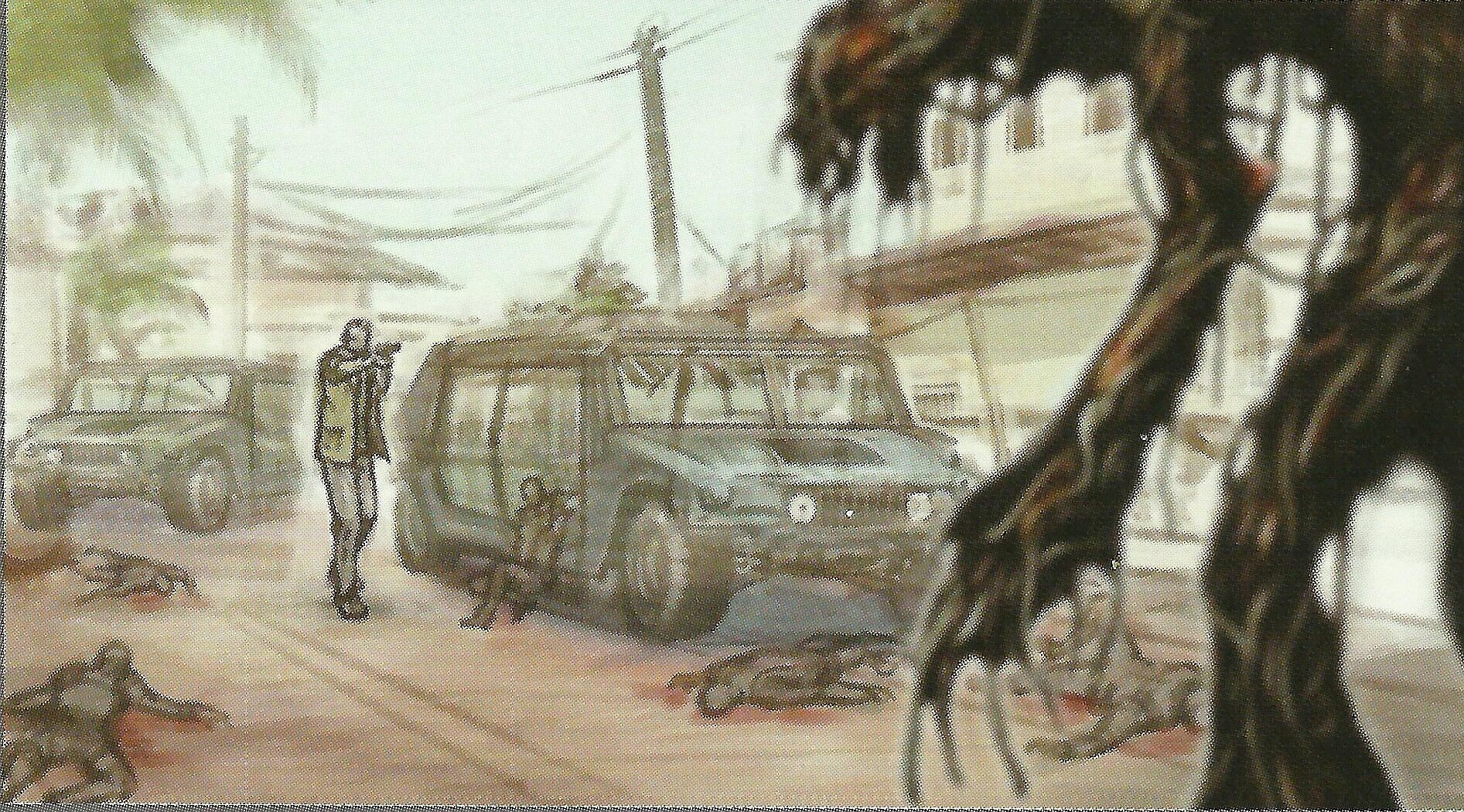
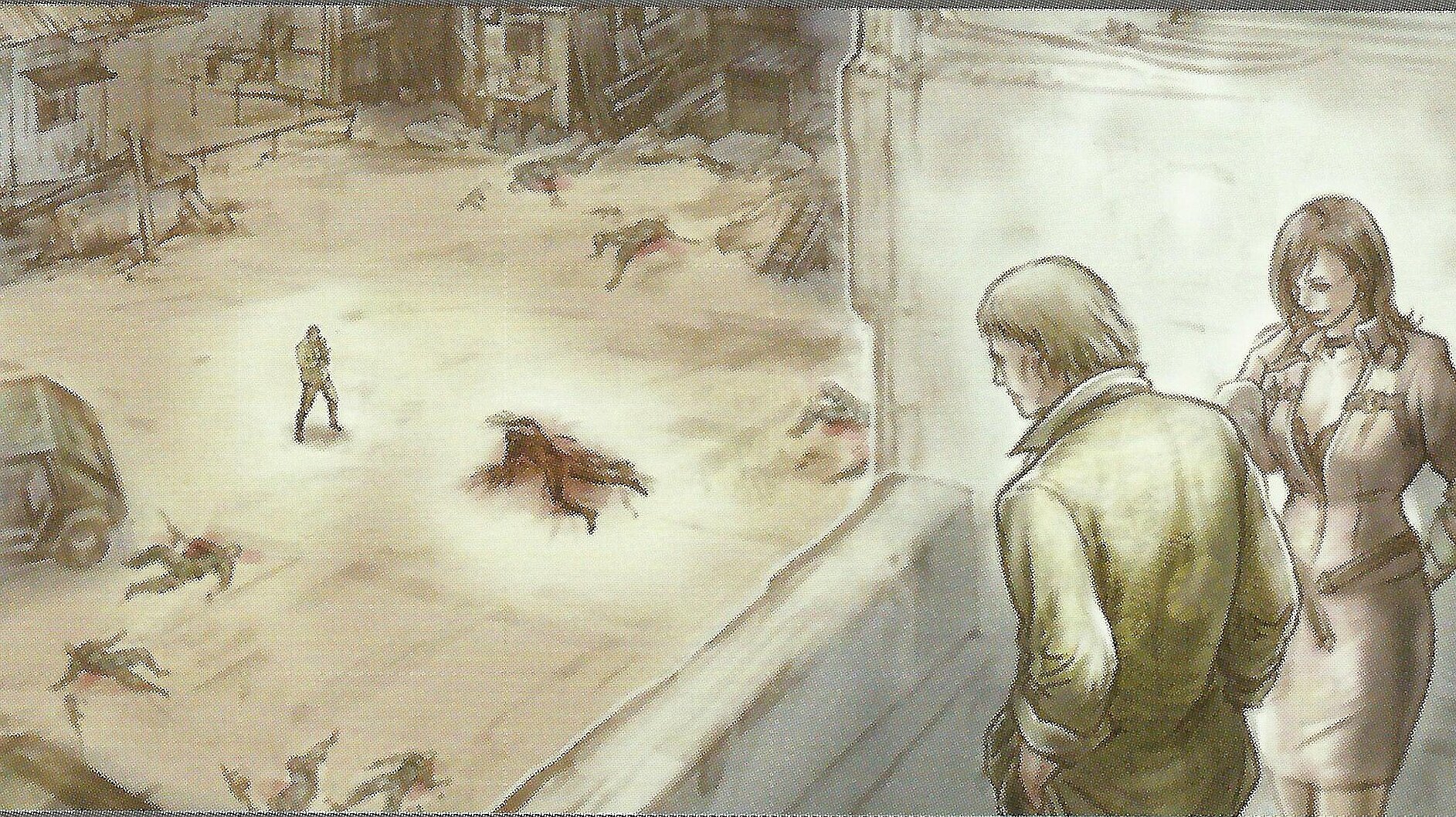
Stated as being the second area, was an indoor shopping district, that had been largely destroyed, in the first city, with an arcade feel to it. This area was designed to involve more use of lighting effects, with shadows and sunlight. The area would be surrounded with shops and retail buildings to show that it was once a bustling bazaar, with the ceiling damaged and cracked, allowing sunlight peering through holes.
Chris would jump across this environment using the pillars to move along, whilst finding items and money; gameplay similar to player's movement in the 'Prince of Persia' series. Zombies in the streets beneath would begin to shake the pillars, trying to force the player to fall into the horde below!
This beta narrative developed with Chris visiting a weapons-dealer store, located in the first city, and securely barricaded, leaving only a slit he could peek through. This black-market trader would question Chris' intentions by asking 'are you a friend or foe?'. The weapons store would be advertised with signs adorned with a gun symbol. The immediate area surrounding the store was barricaded off, forcing Chris to smash his way through to make it to the dealer’s door! These barricades were set-up by the weapons dealer to keep away enemies who had no qualms in infecting him too.
In the first city there was an idea to feature a weapons dealer, similar to Resident Evil 4’s Merchant, with the same design. Inside his shop the player could find bonus items or money, by shooting certain objects, such as a deer head at the back of the store. There was a ladder for the player to climb, gaining access to hidden guns in the room above.
[Beta scenario A/B]
A barricade in the first city had been set up by survivors of the outbreak. Chris Redfield would assist them in defending this barricade. The survivors were armed but not adequately. Their weapons included meager guns, melee weapons and Molotov cocktails.
The survivors try to escape via a car but are involved in an accident, surrounded and outnumbered by zombies. Chris and either Jill or Barry (undecided) arrive, and assist the stranded survivors in battling these zombies.
A scrapped beta scenario with an unknown time-line, involved a horde of zombies bursting through a wall of stacked drum cans (not final), and converging on the player. This scene had loud noises and exaggerated action. The enemies were to jump and frantically climb over obstacles to get at the player, in what would have been extremely tense gameplay.
During the night in the first city, a train crashes and Chris Redfield is attacked by a zombie horde. A fight was to take place between Chris and these zombies, as they clamber over the train, and surround it. Chris Redfield makes it into a brick tower and when reaching the top a cut scene plays; Chris was to meet a 'priest' and potentially find inventory items. At this point the timeline has changed to night, and the environments appear to be very dark. This is the last beta scenario designed that involved zombies. At the next beta development stage that these base enemies are mentioned, they have been switched to the Ganado’s.
Following on from the tower location the player encounters a Ndesu boss fight, structured differently to the final build.
With this beta version using headlights to illuminate the enemy, which would constantly move, vanishing into the dark shadows.
Continuing this beta storyboard, Shimoda san tells us about a scrapped stage that took place at night in the city.
Chris and the first depiction of his co-op partner fought a hoarde of Lickers that would shed their skin to become advanced. The Lickers were to surround the player, appearing from every nook and cranny, but after surviving long enough Chris and partner would receive assistance from their comrades via helicopter support.
This concept scenario continues, with early storyboards depicting a 'City Limits' location, where a boss battle with a branded Ricardo Irving, marked as a biological experiment, was to take place. As discussed above in the section on the first character concepts, Irving's mutation was significantly different than the retail build, as the development team had yet to devise a Uroboros narrative.
A huge desert stage was designed located near to the Marshlands. Anpo-san states that ‘since there was no cover available out there we had to resort to enemies popping out of the sand’. The production director seemed to believe that the gameplay felt slightly like whack-a-mole. The desert scenario involved four of the protagonists including Chris Redfield, and three other unknown protagonists (possibly Sheva, Jill and Josh). When exploring the desert the team find a deserted ship, stranded on land when water receded from the desert to the marshes. Surrounding this area was sparse vegetation, and sporadic water. One would have to presume that the ship was at the beginning, or end of the stage, on the edge of the map. Located on the grounded ship would be a save room, and the weapons dealer would also be available, just outside the shipwreck. Probably used as a checkpoint and break from the enemies, as utilised in Resident Evil 4.
As the scenario progresses, during what appears to be a night scene, Chris Redfield and Sheva Alomar receive word of an abandoned fort from a mysterious informant…
The fort Chris & Sheva receive intel on is the next removed scenario,similar to events staged in the 'public assembly' scene, on a much grander scale.
The abandoned fort was an early stage where Chris, Sheva and comrades (helicopter support) begin an assault on the fort , against a swarm of enemies.
Concept art illusrates large creatures, using spears & rocks in their attack on the team.
As well as air support there appears to be several members of Chris’s team on the ground supporting him, and a Jeep filled with comrades firing weapons.
The enemies are referred to as ‘Militia Ganados’ with similar weapons to those weilded by villagers in the retail version. The area is protected by guards, where a large horde of the Ganado’s have taken up residence.
Somewhere near the fort location is an old floodgate/dam, dilapidated and covered with graffiti. Design instructions for this area were to not to show any religious iconography, as this would be covered in the further stages. Design notes stated that these old buildings were built by Westerners, but they were chased away by the indigenous villagers that had been hiding in the abandoned fort. Additional fort scenarios created in the Summer of 2005 included sequences with many more people than in the final build; this involved a mass battle sequence with twelve allies. This beta gameplay was designed to include a barrage of stones & arrows hurled at the player. The design team took the Battle of Normandy as influence for this concept fight.
The fortress area was designed with several stages to it, which the Ganado’s could use to their advantage attacking from different elevations, such as sliding down slopes. At the central base of the fort, Chris Redfield and his allies are attacked by approx. 15 Gigantes, going berserk throughout the base. The player's objective was to safely move your allies into the fort, from the desert. Players had the ability to manoeuvre the allies out from the desert and inside, using a drawbridge. However the many surrounding enemies are also trying to get into the fort, forcing the player to defend the base too! The player had access to defence mechanisms, such as knocking down drawbridges for allies, and manning machine gun turrets.
Another scrapped scenario for the fort area involved a fight scene at the central base. The entire area had been developed into a fortress with the use of wood scaffolding, and leftover equipment from the mines.
However these ambitious narratives, modelled on a grander scale, and with a generous amount of team back-up on-hand, offering the player significant support, did not encompass the survival horror essence, enjoyed by Resident Evil 5's predecessors. Consequently the fort build for Resident Evil 5 was consigned to the cutting room floor.
"Early on in development the game had more of a war-action game feel to it. There were tons of allies to assist the player, and I always felt that it kind of strayed a little too far from the true style of the Resident Evil series.": Production Director Yasuhiro Anpo (The Art of Resident Evil 5)
[Scenario B] Keeping with the fort scenario ideas, but this stage places Jill in an 'interior version', a power supply room, with design notes stating nothing else would differ from the main fort build. Whilst Jill attempts to repair a power source unit, vital for game progression, the player will control Chris Redfield, having him cover and defend Jill from an attacking Gigante onslaught, trying to scupper her attempts to re-engage power. Further design notes for this idea instruct that Jill is to showcase her technical skill here, and the sequence must make her look cool!
Another idea for the fort section, designed as an interior scene, would have Chris and his team finding themselves inside a large refinery facility, housing a lot of machine equipment, and bustling with much background activity. Chris and the players objective was to overwhelm and suppress the many guards and Ganados working within this facility.
The last idea for an exterior fort scenario, was set in a small valley. Chris and the team had to defend their allies, whilst fending off waves of enemies, including El Gigantes & zombies. The player has access to co-operate with the allies, close off gates and create barricades. Machine gun turrets are again available to use from an elevated vantage point, and players had the ability to shoot large boulders loose, causing them to fall on enemies.
Following on from the Fort location, was a planned abandoned diamond mine scenario, with a wonderfully survival horror theme, 'fear of solitude'. Chris and Sheva enter the mines from the conquered fort, but soon after Chris is separated, finding himself in the bowels of the mine, engulfed in darkness, he's forced to rely on torch-light. In the image (below right) note the creepy creature crawling up the stairs, much like when the player first meets bad Mia Winters, in Resident Evil 7. Design notes make the dumping of this beta scenario very lamentable.
'Separated from the group, the player experiences a fear unlike any Biohazard in the past as they wander through the labyrinthine tunnels.': (The Art of Resident Evil 5)
Prolonging the scenario where Chris Redfield and Sheva Alomar are separated, a cut-scene would have played, depicting Chris falling from a waste management facility, to an unknown subterranean level, leading to the 'Ancient Ruins' section of the game.
Originally the underground city was conceived on a significantly grander scale. From the concept sketches, it appears to be of a much larger design, and far more extravagant; due to the fact that at an early development stage, this beta build narrative involved a considerably advanced civilisation, as compared to the more Neanderthal intellect used in the retail version. The city had been largely flooded, with most of the ruined buildings submerged.
"With so many areas having water running through them, and highly contrasting areas of light and dark, I had a lot of fun drawing this city.": Background Designer Yasuko Shimoda (The Art of Resident Evil 5)
The laser puzzle in the retail game was used in the city but for different purposes. The inhabitants would use the light reflection from the sun bouncing it from several mirrors to a spherical ball that would light the entire city which was shown in a cut scene when entering the Ruins. In the ancient ruins all houses in the underground village had a sphere atop of them with a large hole in the middle which was used to light up the houses. A Prism mechanism was used to bounce light to each home, and whilst these spheres made it into the retail game, they are used as a weapon against you.
"Back when the game was being designed as a single player game, this stage had more of an adventure game atmosphere to it. Once we brought co-op in, we had to reduce the number of traps and mechanisms.": Production Director Yasuhiro Anpo (The Art of Resident Evil 5)
The area had its own Stonehenge style architecture, with more unbalanced rocks. Differing from that seen in the final version of Resident Evil 5, the method for the prism puzzle, involved one large device, near a lake in the middle of the ruins, utilised to bounce light to other smaller prisms.
Frequent use of spheres was a design theme in the beta ancient ruins section. Almost every building, statue, or landmark were covered in as many spheres as would allow. The fascination with this geometrical design, sprung from the inhabitants of these ruins being worshipers of a sun god.
Arguably the reason for the sphere motif theme being abandoned, was these models being too great a strain on the game engine available at that time. Concept designs and ideas for the sphere themed ruins were very ambitious, with another scenario, fated to the cutting room floor, involving a large, rolling sphere, bearing down on the player, engulfed in flames, and manned by a Majini; a far cry from the dull by comparison boulders of Resident Evil 4!
One of the strangest things about an already fascinating and technically challenging stage, were the peculiar homes, designed to be built into the canopy of the cave structures, effectively placing them upside down! Probably the reason this whole stage was scrapped, was Shimoda-san being instructed that sphere designs would surely prove to be too much a drain on technical resources. Throughout the ruins there would be signs of how the ancient underground villagers had made all these spheres but it largely remains a mystery now.
Continuing this beta storyboard, the player uses a large Gondola to navigate a free falling water current. A conversation takes place between Wesker and Excella; we can only presume that this is something Chris Redfield overhears via radio contact, similar to the elevator scene in the retail version, when Chris and Sheva discover Wesker is still alive. Chris then finds himself in an underground mining with family housing, and make-shift scaffolding. He is subsequently attacked by a group of Ganado’s, who until his arrival were digging for treasure. Chris then receives communications from Sheva Alomar, requesting aid, and hurries into a quarry storage area, only to witness Sheva and the group being attacked by an El Gigante! Chris rescues the team and helps defeat the B.O.W.
Afterwards the group head into a collapsed tunnel, referred to as a 'resetting area'. Chris and Sheva have a conversation regarding the ruins. When heading into the next area Chris and Sheva are still conversing when they spot Wesker heading into the pyramid. Suddenly the pair are attacked by a large group of Ganado and, after winning this confrontation, the group head into an area with an imposingly large statue. Here Chris has to solve two connecting puzzles, to create the 'Origin of civilisation'. The next area allows Chris to take somewhat of a break with a bonus treasure game. After solving the 'Origin of civilisation' puzzle, the scenario triggers 'a flash from the ancient weapon, the aurora road appears, granting passage to the sun temple'. The diagram shows a rainbow path of light. Whether or not they are suggesting Chris and team travel across a ray of light, is unknown, it may be a euphemism.
The player next enters the Sun Temple, covered in wall murals & paintings galore. The narrative behind this beta scenario has the ancient villagers worshiping the sun, these decorations are their homages. In keeping with the ancient villagers' theology, the concept sketches below, depict temple walls decorated with religious murals, and iconography to match their devotion to the sun, and other celestial bodies.
The scenario continues to develop, with the player collecting a book item and then a trap activates, a gameplay mechanic to separate Chris Redfield and the rest of his team. Following this Chris engages in a sniper-type game, involving a large mural. Further along in the temple Chris would reach a flooded area where the player would have to swim underwater; the primary goal being to find a way through, whilst using air pockets to catch your breath (similar to Resident Evil 6's Tall Oak’s caverns). Capcom's attention to detail saw the development team implement player air bubbles, as well as encountering sea-life. No enemy designs here, only environmental hazards.
Chris would then enter an area with giant fans, having to navigate his way through them, and into further flooded ruins with the increased danger of 'torpedo traps'. After exiting the water Chris finds an elevator, descending deeper into the ruins. The player would then come under attack from an unknown enemy, whilst descending in the elevator.
Enemy defeated, Chris Redfield traverses a water slope, whilst having to avoid traps on his way down. When reaching the bottom successfully, Chris finds himself in a location titled 'Forgotten Fields' - this area’s primary goal is to develop an ambience for the boss fight to follow. In the garden facility, the original location for the Progenitor flower, Chris encounters Albert Wesker for the first time in-game. The inevitable battle ensues, until the point that Chris’s team (unknown members) arrive to assist in battle. Wesker retreats, but not before releasing an ancient B.O.W.
Although this entire location was re-designed in the final build, with many concept ideas for its inhabitants, architecture and puzzles regrettably scrapped (for both technical and aesthetic reasons), these murals survived to the final build, in slightly different form. The retail version of Resident Evil 5 does include indigenous hand paintings, found on the walls of the revised ancient ruins section; the first two appear before entering the laser lift room.
Another can be found upstairs, in the location where Chris battles Wesker and Jill, in the retail version. Perhaps the Ancient B.O.W. did make it into the final game after all, only his role now reduced to these indigenous diagrams.
Extractions from the Resident Evil 5 disc depicting the source photographs & textures, for these indigenous wall murals, throws up a fascinating theory, regarding the potential origin story for the parasitic creature, which made its first appearance in Resident Evil 4 - the Plaga! The surprising depiction of Plaga, carved into the walls of the African ancient ruins, provokes debate as to the possible birth place of this parasite. Moreover, its location, in the same area where the Progenitor ('stairway to the sun') flower can be found growing, tantalisingly suggests this could be the origins of both.
Image file extracted from the Resident Evil 4 disc by The Chief, of the original plaga design, clearly matches the parasite carvings intriguingly found in this Resident Evil 5 beta scenario.
One theory based on this observation, proposes this the Plaga is a form of mutation, from a creature infected with Progenitor, and that the parasite seen in the native carvings, developed from said creature. An extension of this theory, put forward by Welsh, suggests the creatures shown fighting with the Ndipaya tribe are plaga infected, with a clear resemblance to the Adjule creature, first seen in concept artwork for Resident Evil 4.
More scrapped areas for this 'Ancient Ruins' scenario, not included in the time-line we have been following, and the narrative continues with Chris and his team on the train. There was a beta location designed to represent celestial bodies, but it is not clear what these areas are used for; they seem to interact with the sunlight, so possibly puzzles the player had to solve to open up the next stage. Another scrapped area included a large mechanical gear system, utilised as a calendar. The marked gears would rotate, possibly using the position of the sun to identify the time of year. It appears to be a large, complicated hourglass.
This architectural theme of spherical buildings, with prominent pillars & archways, especially when formed into illogical angles, has a strong resemblance to the unusual designs developed in the artwork of M.C. Escher; perhaps the artist's work was an inspiration for these beta concepts.
The Progenitor flower stage went through various design changes, ranging from an environment rich in dry vegetation, to an area filled with water pools, decorated with stone carvings; a location befitting for when the 'stairway to the sun', was conceived as an aquatic flower, similar in design to water lilies.
Miscellaneous concept artwork for beta scenarios, including night time excavation (perhaps Umbrella or Tricell were excavating the area), a puzzle focused area changing colours using a lighting system, flooded ruins, and more mysteriously decorated archway styled ancient architecture.
Referring back to the narrative with Chris Redfield on board the train; there is concept art for the U-11 Uroboros B.O.W. illustrating it destroying a train. It is possible that this was planned to take place during the laboratory stage, but also a possibility that it could have taken place earlier, when the Zombie horde train crash occurred. A third option, neither occurred, this concept was merely sketched for the purpose of showing the creature in action. There is no further confirmation that Chris ever battled a Uroboros enemy on a train.
Whether or not Chris confronts the train bound Uroboros, the scenario remains the same, as the group head to the labs.
In an early beta design, Sheva Aloma arrives before Chris.
They may have been separated after the train battle, or during the previous ruins stage. Sheva discovers Jill Valentine, held captive in one of the many sealed capsules.
Wesker and the CEO sketched in one of the concept pieces, shown to be walking among a large area filled with similar capsules. Meanwhile in another concept sketch from this scrapped beta scenario, Excella and the CEO are shown in a surveillance room, watching several video screens depicting different characters.
Wesker was originally planned to fall to his demise into the lava; the rocket launcher sequence was later added purely as homage to the series game-play. Excella’s transformation was not part of this beta narrative, instead she would gradually mutate through transitional stages. Much like the retail game Chris is depicted viewing Jill via video feed, isolated in one of the holding capsules. The environment is different but the actual scene is very much the same. Moments after their fall from the Spencer Estate, Wesker is shown to be holding an unconscious Jill Valentine. Wesker’s eye is bleeding and appears to be severely damaged. As we know this damage is due to Jill stabbing him in the eye with her knife. Sheva is surrounded by Excella and her group of human mercenaries, who do not appear to be infected. She is consequently taken captive, shown tied to a wall in this beta concept sketch.
During Scenario B, Chris Redfield and a place-holder partner are shown storming a group of Majini, gathering below an un-named captive, possibly Sheva Alomar, who the pair race towards. This leads to gameplay involving Chris, and his yet to be decided co-op partner, battling to effect a rescue. The storyboard for this beta narrative continues with Chris discovering Sheva’s location, and assessing the situation, he takes cover behind a wall, spying on a suspicious acting Excella Gionne. Potential gameplay could have included Chris despatching her mercenary bodyguards, whilst Excella fleas. Again, taken from Scenario B, Sheva and Jill are shown shaking hands, which was to occur after Chris and Jill rescue Sheva.
Chris and Jill are shown moments after her capsule release, and she appears very disorientated. In this beta scenario, Jill wears the same outfit worn during her Lost in Nightmares mission; she is not depicted in her battle suit in any of the concept art. After Jill's rescue, Excella is shown with a device activating the P90, turning Jill against Chris. After managing to remove the device, he heads off in pursuit of Excella and Wesker. Sheva Alomar has now arrived on the scene, and stays behind to care for Jill. Meanwhile, the CEO is betrayed by Wesker and Excella. Wesker is shown shooting the CEO in the chest, whilst Excella and Chris look on.
The ship stage was originally constructed to be open-world, enabling the player free, non-linear exploration, however this freedom afforded to the gameplay lead the design team to get carried away with ambition, and the size of the ship had to be scaled down for retail.
A Tyrant was originally included at this beta stage, with Albert Wesker having the ability to control and order the B.O.W. to execute Excella Gionne. The Tyrant impales her through the chest, while Chris looks on; probably the set-up to a Chris/Tyrant boss battle. Moments after his first in-game fight with Wesker, Jill Valentine appears to save Chris, who has been beaten within an inch of his life. Sheva Alomar also appears on the scene. Chris, Jill and Sheva are now shown using a computer terminal, for what purpose is unknown; perhaps tracking Wesker. The next cell in this beta scenario storyboard, depicts Chris Redfield racing off with purpose, whilst instructing Jill and Sheva to make haste in the opposite direction; probably pursuing Albert Wesker moments before the finale boss battle.
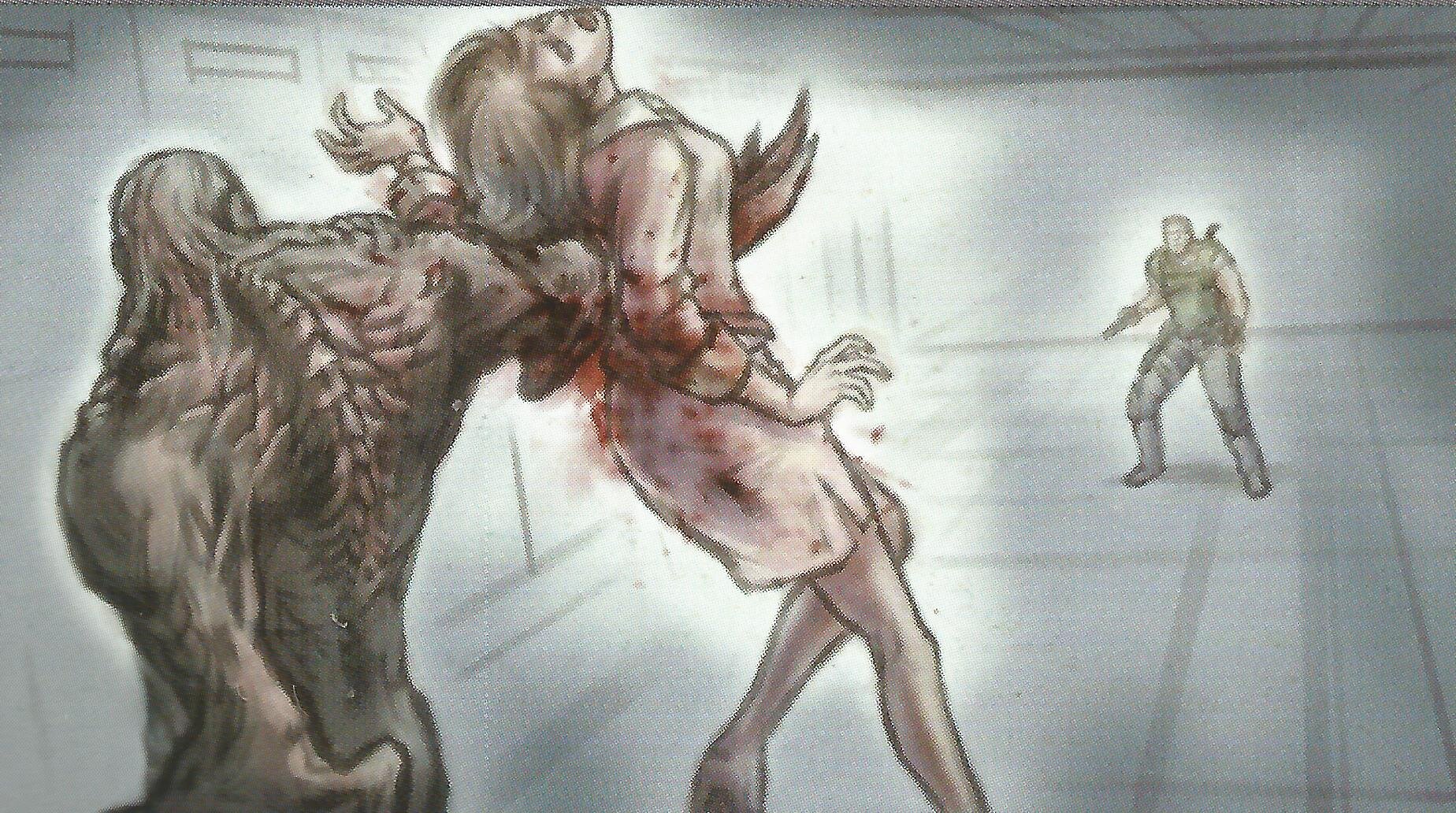
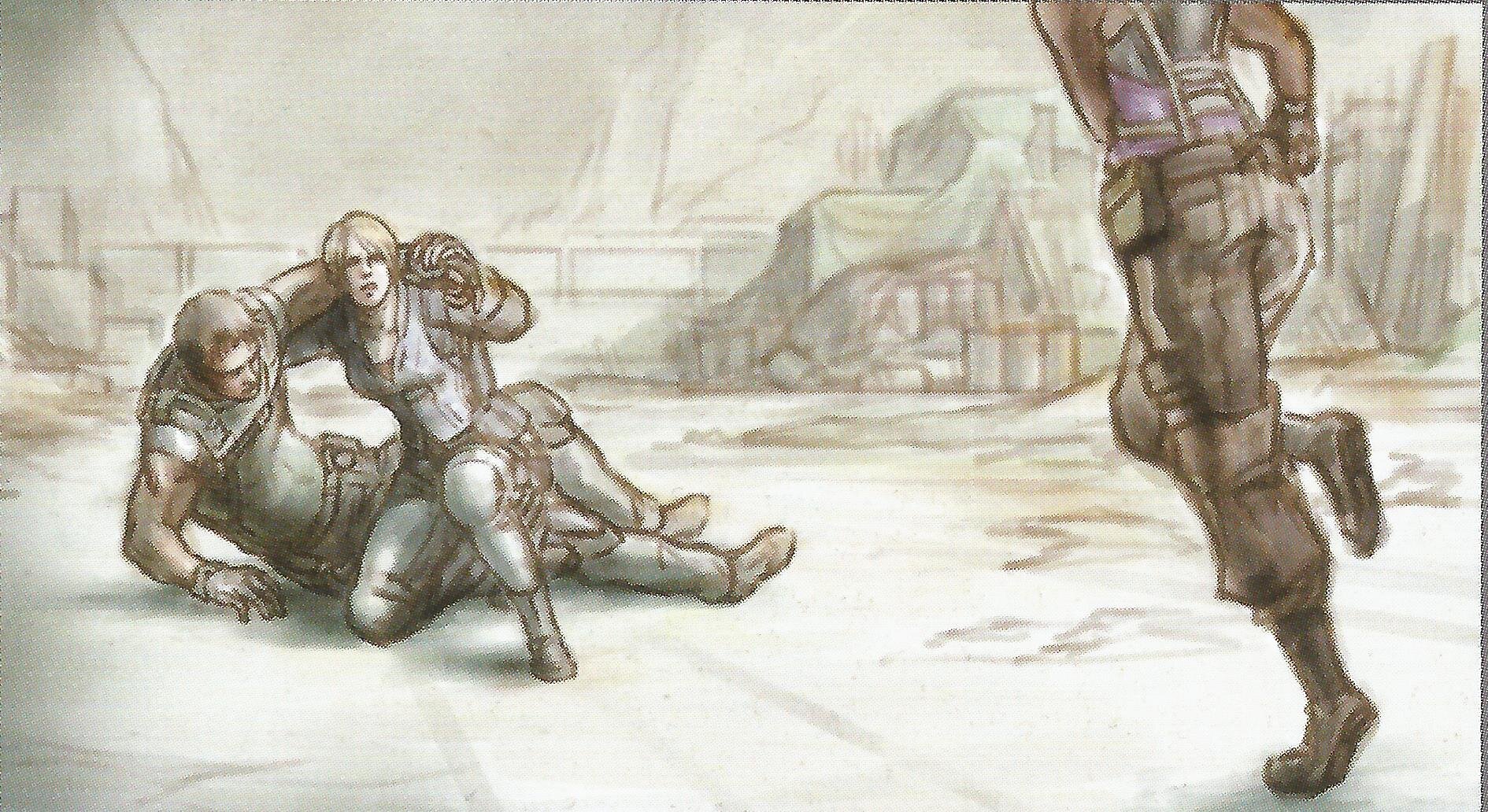
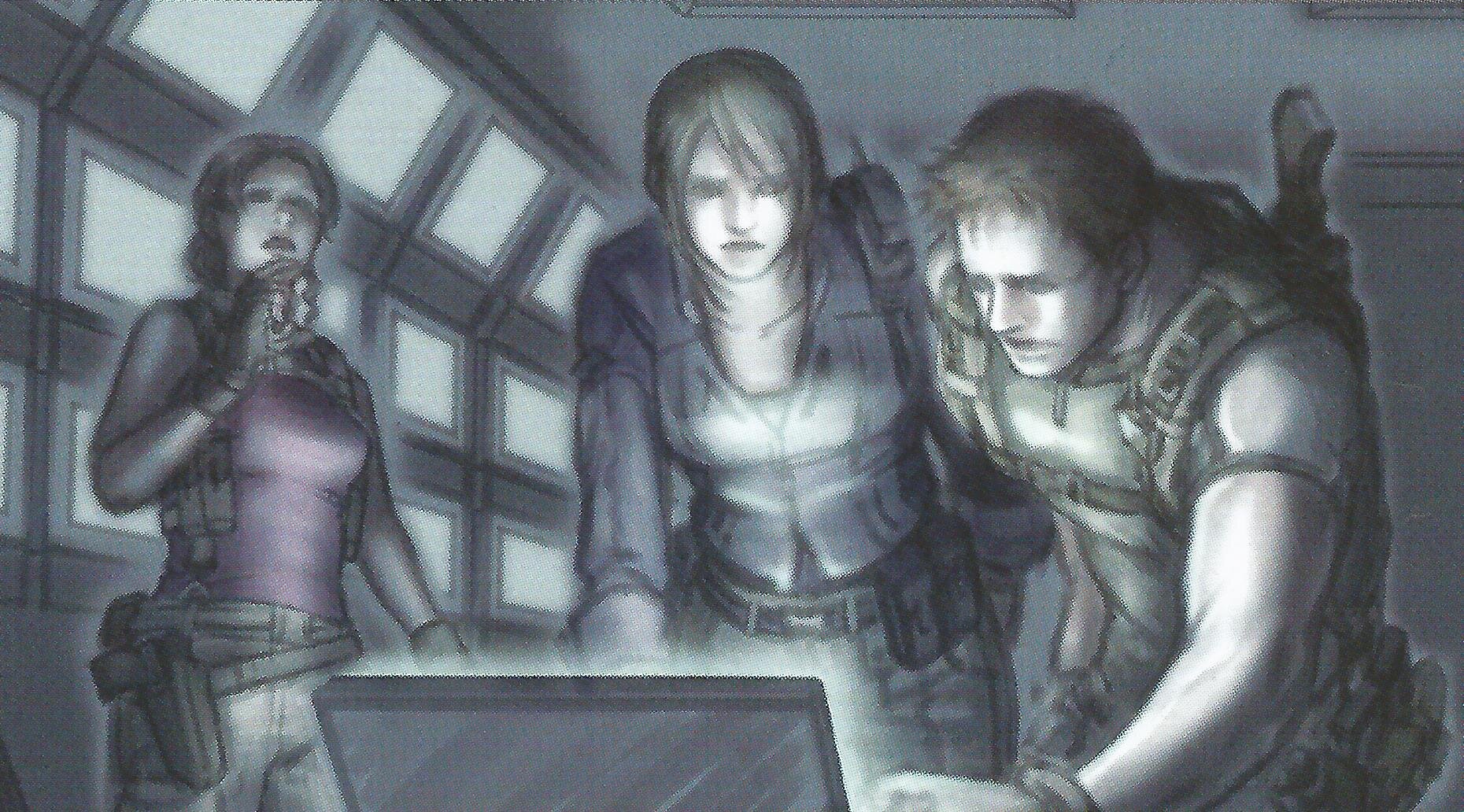

An injured Chris Redfield is shown once again, beaten and on his knees, whilst an onlooking Wesker taunts him, Sheva Alomar is in shot, distracting Wesker and consequently saving Chris. She fires her weapon, hitting Wesker in his damaged eye (caused by Jill stabbing it with her knife during their Spencer Estate battle). This was Wesker’s true weakness and was thus used to finally defeat him, in this beta narrative. Wesker is shown in human form, not mutated with Uroborus. The final boss battle for Resident Evil 5 at beta stage, was to be a raw battle between Chris and an Albert Wesker free of the circling Uroboros tentacles and appendages upgraded with chunks of metal, that he was afforded in the retail version. These bonuses were added to enhance Wesker for a fairer fight, since it was now 2 vs 1. The storyboard continues with Chris Redfield climbing into the plane, triumphant after finally defeating his nemesis.

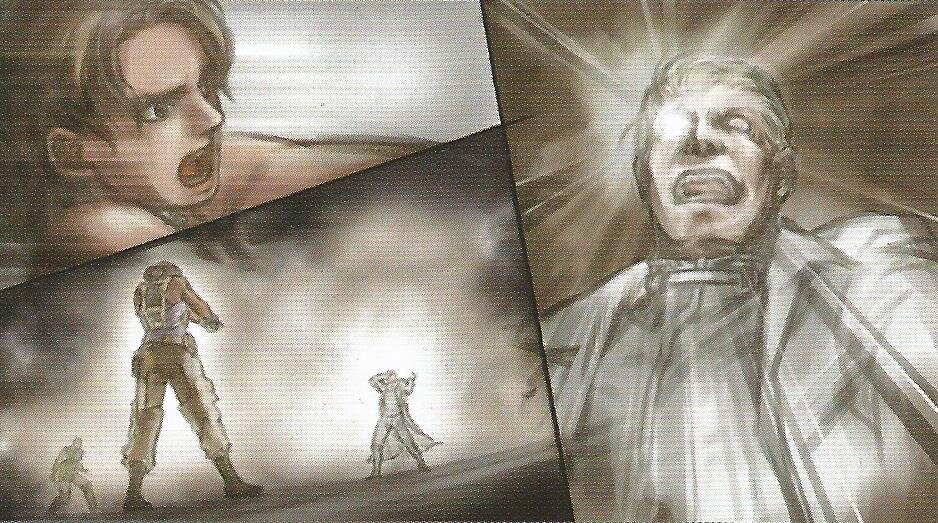
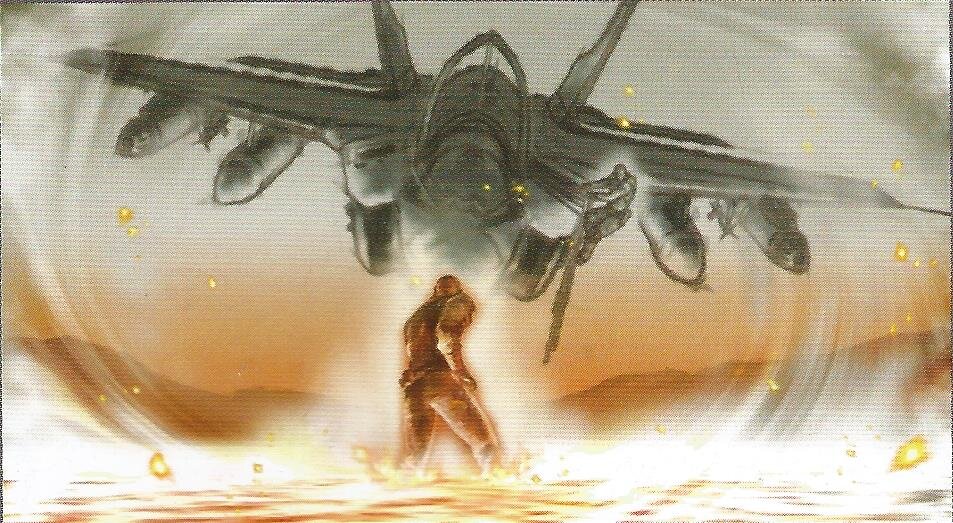
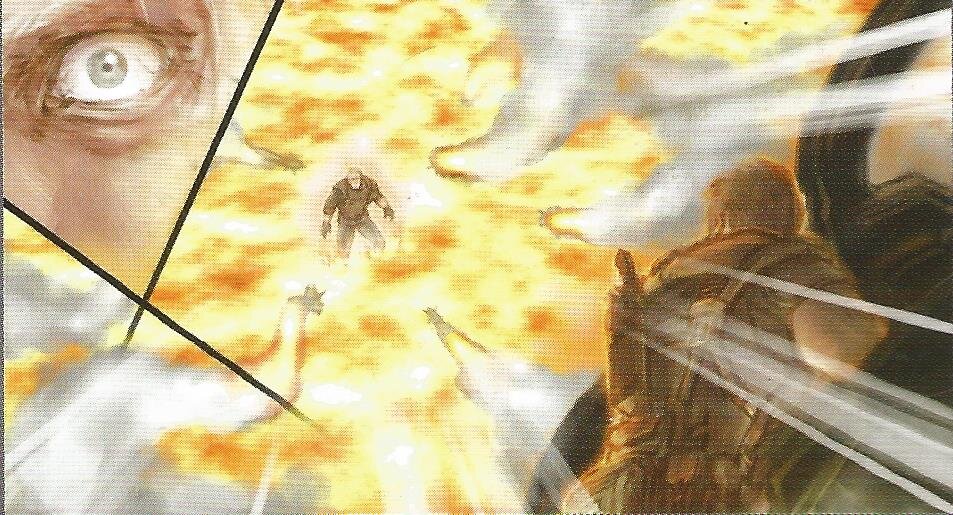
Chris is shown assisting Sheva with the controls of the plane as they leave the area and head to safety. After arriving on a landing strip the heroes are shown leaving the ship and walking away, in the beta version of the game's ending.
Miscellaneous beta concepts and cut materials
Variant Opening Cut Scene: Early beta stage storyboard which illustrates Jill Valentine callously infecting an unknown captive, tied to a chair with Uroboros. An early, arguably first incarnation of the retail game's opening scene.
Ancient Ruins Fire Balls: Spectacular gameplay enjoyed from the retail version of Resident Evil 5, featured large spherical balls of fire. These unforgettable obstacles roll onto the stage where Chris Redfield and Sheva Alomar have to hurriedly dodge, whilst also attempting to stop a fatally closing wall, achieved by triggering a pressure plate. At beta stage these fire balls originally had a menacing Majini inside each one! However, Anpo-san confirmed that this idea was scrapped due to the unwanted, context jarring comedy involved when these Majini riders, ejected out from the flaming wheels, in a crazed, dizzy state!
U-8 Boss Fight Environmental Damage: Inside the large room where Chris Redfield encounters Jill Valentine in the retail version, the design team wanted to insert a human captive into every capsule, and also have the lift platform moving, whilst the player battles U8, stumbling into the capsules and knocking them off the wall.
Experimental Phase: Set inside a run-down building, the Resident Evil 5 development team used this stage specifically for reasons of gameplay testing. Community member USS Command states that the environment consisted of only a few rooms, some with beds, however the player did not have the ability to leave the area and venture outside
In a map built solely for testing purposes this area resembles the retail version of Public Assembly and was used to create early trailers that we are going to look at. The team did once consider introducing a set-piece where the Majini tip the bus on its side (this was included in the E3 2007 Extended Trailer which I will touch upon later). The Majini to Chris’s left in the bottom left picture is a waiting stance. Chris can be seen avoiding melee attacks from machete wielding Majini. This dodging technique could be implemented by pressing the dodge feature at the correct time (like Resident Evil 3). And more images from this beta test stage reveal an assault rifle not in the final build. Also note the size of Chris’s arms here. They appear much thicker than in the retail version. One image reveals the Majini had the ability to pick up chairs to use them against Chris.
Biohazard 5 Beta Trailer
As discussed at the start of this article, the début trailer for Biohazard 5 premièred at the Tokyo Game Show, in late 2005. Game producers Jun Takeuchi and Masachika Kawata have confirmed how light and dark environments were key goals during the production of Resident Evil 5, and this early trailer makes excellent use of transitioning the frames from dark, into light. This première trailer should be considered very much a concept work in progress, the representation of a general theme, and not definitive of the finished narrative & product.
Lighting in particular was a key focus for the trailer's conception; its scenes showcase in particular the type of environment, lighting, and tone. As can be seen in the two frames below, light shines through into the dark area creating a beautiful effect. This environment oozes atmosphere.The retail product has similar moments to match the style emphasised here, however I do not feel these were consistent through the game, with a different direction preferred that moved away from some of the themes seen in this beta stage trailer (including the deserted streets, marauding zombies, and tense, slower pace).
Here we can see the adjustment between light and dark environments is emphasised, with the appearance of the Chris Redfield beta character model, a considerably younger and less muscular design to the revised, retail model. Furthermore, Chris's uniform is significantly different to the one he sports in further trailers and the retail build, being almost t-shirt like, in its lack of B.S.A.A. logo identification, and non-camouflage colour.
Very bright environments, using a range of different colours, from light pastel shades for the African architecture, to contrasting primary colours for decoration. The final build of the game I feel misses the benefit of using such varying colour palettes.
We know that during these beta stages zombies were the main enemy, shown through these sinister silhouettes, shambling on screen. But in the following frame these (presumably) same zombies are shown suddenly sprinting very purposefully towards the player, barrelling in tandem around the corner. No reference to any virus or Crimson Head type mutation, so it remains unknown as to how these zombies we able to move with such speed. Had these frames been separated by two differing trailers, one could presume the silhouettes belonging to differing types of enemy; one slow marauding zombie, the other rushing horde, possibly revised Majini.
Chris is sporting a modified Silver Ghost handgun in the beta trailer, which did not appear in the retail game. This handgun débuted in Resident Evil 4 , as Leon S. Kennedy’s starting weapon. The gun also appeared in Resident Evil The Umbrella Chronicles, Resident Evil Degeneration, and even makes cameo appearances in Resident Evil The Deck Building Game and Marvel Vs Capcom 3: Fate of Two Worlds.
It would not be for almost a further two years, until the second trailer for Resident Evil 5 was aired, at the Electronics Entertainment Expo 2007.
The music has a tradditional African vibe and does not appear in the retail game. Chris’s introduction from Resident Evil 5's opening plays here, prior to its revision for final release. But that isn’t the only production edit, with Roger C. Smith's cadence being audibly different with this delivery.
The area in the screenshot below, was completely scrapped from the later build, or at the very least it has been considerably re-designed. Notice the shape of the building in the background, behind the tree. There are also goats roaming the street, only seen in the retail build locked in cages.
Although this area is in the retail version (image below left), the 'Friday Night' banners are of a different design than in the final build. Also note the tall, white building in the background, where you can spot the Agitator Majini in the retail version. This area is to Chris Redfield's left when the player takes control for the first time.
Although the scenario in the screenshot (image below right) makes it to retail build, the iconic 'Executioner' enemy makes no appearance here. Alternatively his role is given to the chainsaw wielding Majini, but minus his chainsaw; here he wields the large modified axe, soon to be gifted to his physically superior successor!
Also Reynard Fisher is missing from this scene, seen in his fateful place, is an unidentified prisoner, tied upside down. He does not appear to be Reynard, and may simply be a place-holder for a planned character, yet to be fully realised by the design team. Also notice the unusual wooden structure to the right, from which this unfortunate captive hangs; it is not in the retail build.
The first close shot of revised Chris Redfield character model shows a more mature looking man, with significantly larger upper-body muscle, and a re-designed uniform, now sporting his B.S.A.A. logo and the more recognisably military colour khaki, compared to the model seen in the début 2005 trailer.
This section in the below screenshot was scrapped from the retail build.
A large group of Majini surround Chris Redfield, in an unknown location, scrapped from the final version. It is possible this is an earlier concept for the retail version's 'Public Assembly' area, although there are design differences.
Majini’s swing melee weapons at the player, he manages to avoid by ducking, a manoeuvre not carried through as a feature for the final build..
For these first trailers, skin colour of all Majini now matches a darker West African pigmentation, with no mix of other ethnicity. This was a contentious point, not for industry insiders, but a section of gamers made accusations of racism.
Capcom, guilty of no more than insensitivity, changed character skin tones in post-production, to include diverse pigments, more representative of wider racial heritage.
Another scrapped location, in the below screenshot, which also showcases the larger crowds of chasing enemies that pursue and surround the player (who during this beta build was afforded the privilege of a defensive ducking maneuver!). These larger, pursuing crowds frequently seen during the 2007 trailer, seems to have been planned for the retail game, but were presumably dropped due to technical limitation. This large crowd storm toward Chris, hurling machetes and other projectile weapons.
Further locations that were left on the cutting-room floor.
Further cut content in the collection of screens below, including beta weapons, removed areas, and experimental gameplay: The player unloads a machine gun that is not available in the retail version, a M4A1 Carbine. This assault rifle played a key role in Resident Evil 3 Nemesis. Used by Carlos and Mikhail this rifle has an automatic and manual mode and uses 5.56mm NATO rounds.
More shots of this mysterious map features Chris Redfield attcked by three Majini, all wielding axes, and all about to strike the player simultaneously. This enemy attack feature is not a gameplay mechanic available in the final build, as these enemies are restricted to only hit the player one at a time. Again, technical limitation is the most likely reason for this.
The last two screens showcase removed weapons. We see Chris equipped with a Benelli M3, and whilst a similar shotgun appears in the retail build, this variant model replacing the beta weapon, had significant design alterations. And a M1911 Handgun, very similar to the one used by Ethan in the Resident Evil 7 biohazard demo, Kevin Ryman in Resident Evil Outbreak, and Billy Coen in Resident Evil zero. Despite being featured in this trailer, it was not an equipable weapon in the final game build.
Opening her eyes, Jill awakens in her capsule, the closing shot from E3's trailer, but not appearing in the final game. This could certainly be a small part of larger beta footage, cut from the retail build.
The third trailer, for 'Captivate 08', also shown at Electronics Entertainment Expo that year, and still containing significant scrapped material, was to showcase Resident Evil 5 for Xbox 360.
Chris uses an opening monologue here, that is different to the retail version.
In the screenshot (below right), Chris Redfield struggles with multiple enemies on the balcony that only Sheva Alomar can gain access to in the retail version, and we can now see a broader range of skin tone for the marauding enemies, as compared to the universally darker skin colour of all Majini in the previous two trailers. Capcom went on to deny that the racism controversy had any influence on the game, in a Kotaku article. And another image (below left) of Chris Redfield's M4A1 which never made it into retail.
Equipped with sniper rifle (image below left), Chris takes aim at the bridge crossed during retail gameplay, but interestingly the location where Chris is positioned did not make it to the released game build. The two enemy character models in the screenshot (below right), do not appear in the retail game. One appears to have barnacles covering his head, while the other is dressed in tribal clothing.
The final Resident Evil 5 trailer that can be dissected for significant cut material, was showcased in Germany 2008, at the Leipzig Games Convention.
Various scrapped playable locations, including a night time scene which probably took place just before, or after the confrontation with Ndesu, and the area which provided the Majini biker cut-scene & QTE in the retail build, is seen here as a playable stage for both characters.
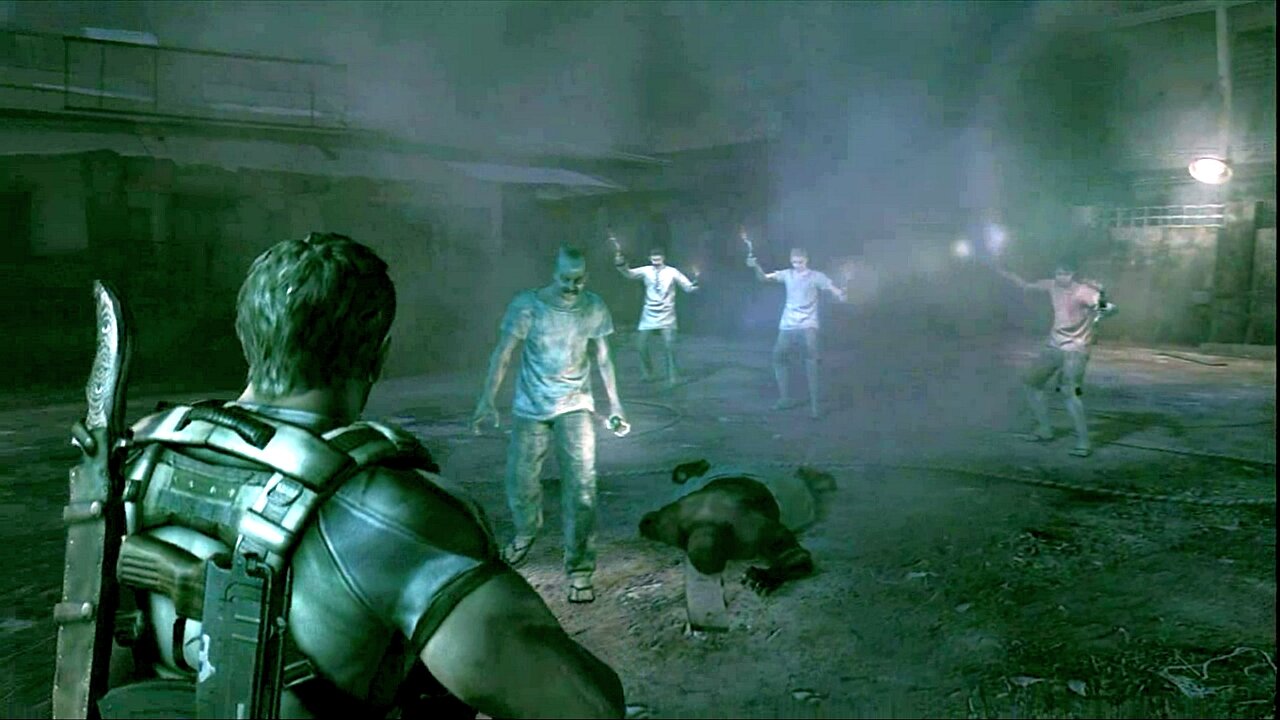
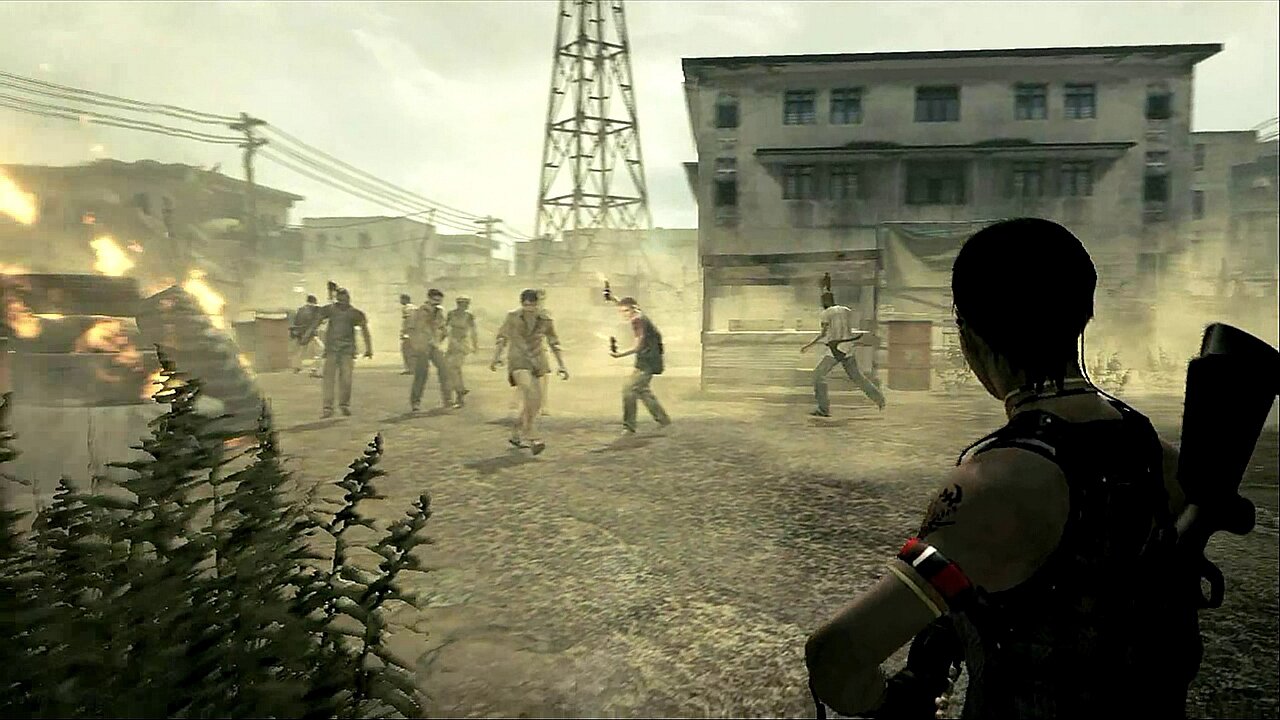
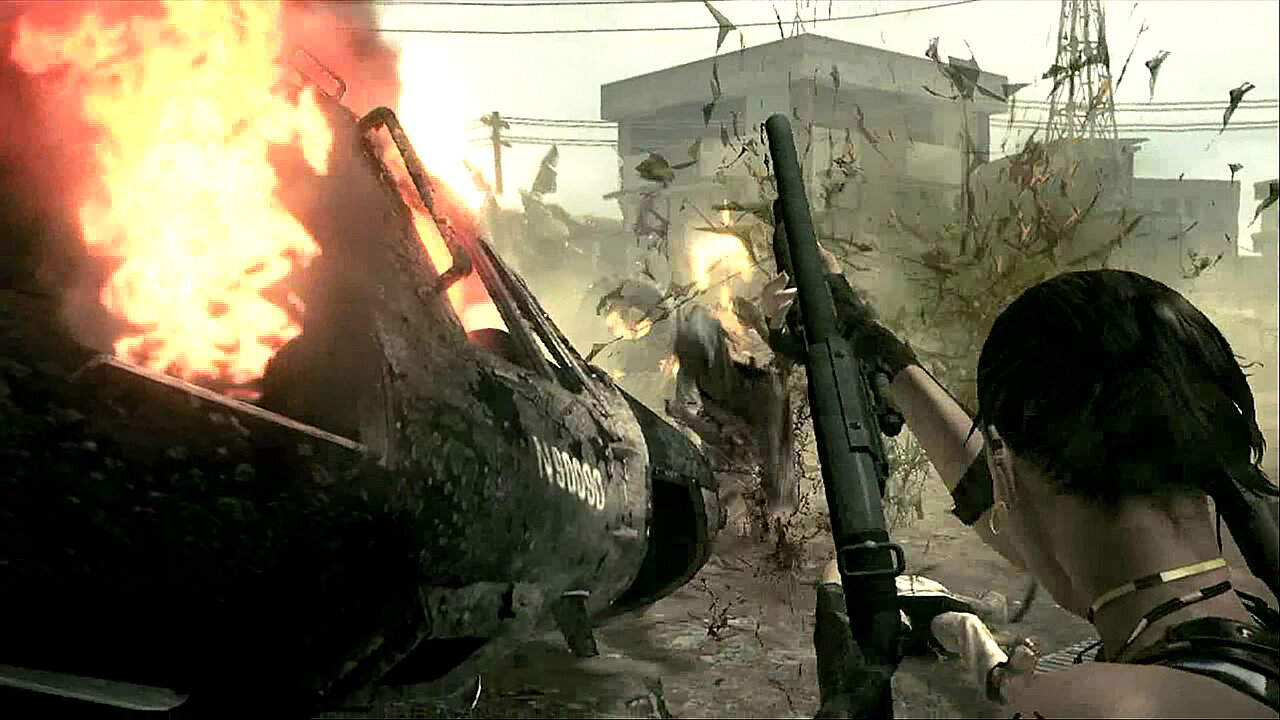
We can see early world building concept art for this location, designed for gameplay (image below left), Kipepeo appear in the Stairway to the sun area, but were not present in that location in the retail build (image below right).
Beta Dialogue
Sheva Alomar - Scrapped dialogue, consigned to the cutting-room floor, (until extracted from the retail disc by BSSArklay), included an insightful little epilogue by Sheva Alomar, reminiscent of the Resident Evil 3 epilogues:
'Sheva's Epilogue': "Of the approximately 3000 terrorist incidents involving BOW’s annually. The BSAA is despatched to handle roughly one third of the most series infractions. This mission represents only one of those thousands of incidents. The success of this mission however saved the lives of every man, woman and child on the planet."
Albert Wesker: Dialogue for Wesker, cut from the retail game build included a nice little piece where the antagonist explains he is not a king, but a God, and even Kings will bow to Gods! Further lines include taunts aimed at both Chris & Sheva, and a variant line for longer duration boss fight.
Chris Redfield: Scrapped beta dialogue from Chris includes an unusual catchphrase (uploaded in the audio box below). I guess Capcom were aiming for humour here, but perhaps it was cut due to its unusual style of humour! The same can be said of the following scrapped audio; it appears Capcom wrote this line for Chris to poke fun at himself, much like they implemented in later games, Revelations 2 & Resident Evil 7 biohazard. Like the films 'Scream', 'Shaun of the Dead' and most recently 'Deadpool' it could be seen as a breaking-the-fourth-wall reference.
Laboratory Alert: During the boss fight with the Uroboros B.O.W. located inside the laboratory area when Chris & Sheva use the flame-thrower. Originally there was a VA system with a computerised female voice informing us about the breach in the lab and the status of the flame-thrower. In the retail version this was replaced by a flashing red and green light system to let us know when the flame thrower was charging and fully charged.
Ndipya Conversation: Chris and Sheva share dialogue regarding the behavior of the Ndipya Villagers, during the Ancient Ruins scenario. Sheva also shares historic details of the tribe’s culture and architecture to Chris.
Beta Inventory
A comprehensive file search of the Resident Evil 5 game disc, unfortunately only reveals two scrapped beta inventory items. An image file of a mysterious scroll, alongside the other image files for those items that did make it to retail build, plus an interesting texture for the variant medicinal herbs that can be found in-game. As can be seen from the other extraction, a texture for in-game item medicinal herb, there are four variant types listed, labeled 'type A. B. C. and D'. Although green, blue, and red colour variants are included here as a resource, the blue herb does not make an appearance in the released game build.
Beta NPCs
The Merchant: Previously featured in Resident Evil 4, a gameplay feature providing weapon purchases & upgrades, realised in NPC form as the Merchant, also appeared in the Resident Evil 5 beta.
The Merchant was planned to interact with Chris Redfield from behind a closed door, with letterbox style peep hole, and ask "Friend or Foe". Any trade deals would pass through this opening, and so Capcom only needed to create the character model’s eyes. From this file extracted by BSAArklay from the Resident Evil 5 disc, fans of the film 'Silence of the Lambs', may notice the eyes used were from Sir Anthony Hopkins
Beta B.O.W.s
The G-Human: Keep an open mind for this one! G-Humans have been a much talked about B.O.W. within the series, particularly surrounding Resident Evil 4 beta gameplay. Commonly known as the 'Castle' or 'Fog' build, its scenario designer Yasuhisa Kawamura (in interview with Crimson-Head.com) confirmed this beta NPC was designed as part of his origin story for the 'progenitor virus'.
Another extraction, and the name of this image file 'g-humann01_bm' alone captures ones attention. However, this character model is placed within the same disc location as image files for the capsules found in the Resident Evil 5 underground laboratory area, close to Jill Valentine’s empty capsule. It is more than likely this 'G-Human01_bm' is a place-holder name for test subjects within these capsules.
Most B.O.W.s and secondary infectants conceived by the design team went through various states of amendment, as the enemy concept is realised from beta sketch, to finished retail cast member. The Bui Kichwa B.O.W. for Resident Evil 5 was no exception, yet whilst most unwanted beta designs would be lost to the cutting-room floor, an early concept for this creature found itself re-used, in the subsequent release, almost a decade later, of Capcom's 'Umbrella Corps', as seen in the screenshot below, from the game's Kijuju stage (identified by TheBatman on The Resident Evil Podcast #35)
Biohazard 5 DLC Beta & cut content
During the Resident Evil 5 Gold Edition (Directors Note) interview (archived by Resident Evil Database), the director for both main game & DLC, Yasuhiro Ampo, identified the catalyst for 'Lost in Nightmares' & 'Desperate Escape' scenarios being kept over for a separate, subsequent release, being Resident Evil 5's considerable popularity. Ampo-san confirmed the decision to implement 'Lost in Nightmares' & 'Desperate Escape' scenarios as bonus modes for completing the main game, occurred very late into development; this also had the disadvantage of no longer gaining access to Hollywood studios that produced the high quality, main game cut-scenes. Furthermore, in Weekly Famitsu (Sept 29th 2009) Jun Takeuchi confirmed the 'Lost in Nightmares' episode was originally planned as part of the main game retail release, but during development the team decided it didn't fit with the flow of the rest of the game.
At one stage the development team did consider making American comic style cut-scenes, but despite their best efforts, this concept could not be realised to Capcom's satisfaction. After the game launched Capcom received feedback from the fans, with one of the most demanded requests being a playable Jill Valentine; this feedback provoked the decision to create the scenario for 'Lost in Nightmares'.
Yasuhiro Ampo's team wanted to make a traditional episode, paying homage to the original Resident Evil. Ampo-san himself had worked on the original game, although joining the project late on, he claims that he owes a debt of thanks to this first instalment, for the inspiration behind 'Lost in Nightmares'. Interestingly, he states its narrative was already in existence as a concept, even prior to the co-op mechanic being implemented; although it appears to have been single player when originally envisioned, as Ampo-san states the scenario had to then be re-envisioned for a co-op partner mechanic. Jill's addition into the DLC was then a forgone conclusion, as many on the team also wanted her to be a playable character during part of the main game.
The 'Desperate Escape' scenario was originally planned as a bonus mission, discarded during the later builds approaching retail, but then this scrapped scenario was fortunately revived as DLC, due to a large number of fan feedback demanding to play as Jill Valentine. Josh was a popular character amongst the team so Capcom decided to implement him into DLC. Original plans for Josh Stone saw him perish during the oil refinery location.
Sheva’s original plan as a guide for Chris Redfield, was during the boat section, just prior to fighting Iriving, and she was to steer the boat during the pursuit for Irving, with Chris boarding the antagonist's boat alone. However when Sheva joined Chris as co-op partner, boarded the boat together, the development team then required a new character to steer, hence Josh's return. Ampo san knew that Jill would play one of the main characters during the 'Desperate Escape' scenario, but didn't know who the other character would be; luckily Josh Stone being available, allowed him to became her Jill Valentine's partner by default.
Scrapped Guardian information: Capcom Unity ran a promotion allowing five lucky winners to submit their chosen questions to one of the development team. This in turn has shed fascinating light on the earliest concepts for this scenario. Capcom stated that they would have liked to have implemented Hunters into 'Lost in Nightmares'. The most fascinating response though comes from the second winning entry:
Q. "How did the Guardian of Insanity come to be, and where did they get their anchors?"
A. “Spencer was conducting top-secret human experiments, in the basement of his mansion.
The Guardians of Insanity are the victims of the cruel experiments where innocent people are exposed to the virus.
Spencer’s mansion is located near the harbour warehouses, and the Guardians of Insanity seem to have access to those warehouse facilities through one of the mansion’s many secret underground pathways.”
The Guardians seem to wander around the area so perhaps that’s where they got their anchors. A likely location for these harbour warehouses, has been identified in the concept art (image left) of Oswell E. Spencer's castle.
The title 'Lost in Nightmares' was created to express "Chris’s profound sense of loss and the fear of unforgettable nightmare. Capcom also admitted they did not have access to the same orchestral recording & Hollywood production studios when creating this scenario, forcing the development team to spend considerable more time designing cut-scenes that could match the quality of the main game. Below we can see source photographs of environmental features, taken by Capcom to use as textures for cliffs, and stone architecture for the Spencer Estate.
It's common for Capcom to send scenario artists & designers to particular environments, that may inspire concepts during early development, and also offer the opportunity to take source photographs for the textures, for natural & man-made structures; for example when community member Welsh extracted files from the Resident Evil remake disc, a search through its catalogue revealed the location for source photographs that provided textures for Spencer's mansion, Chepstow Castle in Wales. The photographs below, extracted from the Resident Evil 5 disc, were taken in the very earliest development stage for the 'Lost in Nightmares' scenario.
The debut trailer for Lost In Nightmares would also include content that would not make the cut to retail:
Chris & Jill enter the mansion, however in the retail version once entering the mansion the player takes immediate control. Jill then uses the corner wall for cover in another scene not included in the retail build. Chris and Jill enter the dining room, another scene deleted from the released cut, surveying the room, with their weapons drawn.
A possible explanation for what happened to the dining room banister is alluded to; notice the wood beneath Jill on the dining room table - what would have caused Jill to have fallen here?
Chris is then seen in an area that is not accessible in the retail build, only Jill can access this area after Chris gives her a boost across the gap.
In the library where Chris and Jill face Wesker, Jill appears to be shouting to someone, and in the retail game this mirrors the sequence when Chris is grabbed and hoisted up into the air by Wesker, moments before Jill tackles him out the window. However in this version Chris stands by his partner’s side.
Probably just a shot for the trailer, but the finale shot of a back-to-back pose between Chris and Jill is nowhere to be found in the retail version. At the end of the trailer in a post credit scene, Chris is shown using a crank, and in dialogue not heard in the game, quips “What is it with this guy and cranks?”. Jill responds “He’s a man of refined taste”. Chris adds “He’s obsessed, that’s what he is”.
Lost in Nightmares cut dialogue:
Jill questions Chris about a woman; this conversation takes place after their “Kind of takes you back to Raccoon City” conversation:
(Regarding a file)
Chris “You think it’s talking about Wesker?”
Jill “You think this could be Wesker?”
Chris “So there is a connection between Spencer and Wesker.”
Jill “The sooner we apprehend Spencer the closer we will be to finding Wesker. There can be no doubt about it now Spencer and Wesker are connected.”
Chris “I just hope he knows where to find Wesker. Come on let’s get going.”
(Regarding the Itchy Tasty file)
Chris “I feel like I’ve read this before.”
Jill “I can’t help but feel I’ve read this somewhere before.”
Sources: The Art of Resident Evil 5, Project Umbrella Developer interview Database, Resident Evil 5 Official GuideSpecial Thanks: George Trevor, USS Command, 3A7, News Bot, Rombie, TheBatman, Welsh, CaptainRedfield, Monique Alves.








